25 Best Webinar Software Platforms of 2025 (Top 3 Picks)

Webinar software is one of the best ways to engage with leads and move them down the sales funnel.
As many as 95% of companies believe webinars can help them achieve their business goals.
However, choosing webinar software and then hosting live webinars can be challenging.
While webinars themselves are a great way to combine video conferencing and marketing automation, the devil is in the details:
- What is the waiting room experience for your viewers?
- How easily can viewers download the plugin and join the meeting?
- How many presenters can you have at one time?
- How high-quality is the audio?
- How many viewers can you present to at one time?
What is the Best Webinar Software?
1. Demio.
Best Webinar Software for Marketing (30% Off).

Adam’s Take
I know firsthand the importance of marketing your online events. Not only do you need webinar software that works well during the event, but also marketing tools that can easily make sharing the news about your webinar a breeze. Demio gives you the best of both worlds while providing a seamless experience. For these reasons, I recommend Demio if you want a webinar solution that includes all the necessary marketing tools.
Best For
Webinar and Integrated Marketing Tools
Price
$34/mo – $69/mo
Annual Discount
Yes – Save 30%
Promotion
Demio is another of my top picks and has a great combination of no-download webinars for your audience and marketing tools to generate more leads.
Regarding visual aesthetics, it delivers real-time HD streaming video and is a great-looking platform.
Everything is customized to match your brand, and they have all the video conferencing features you need: live and automated webinars, replays, registration landing pages, etc.
All pricing plans offer standard features, including advanced webinar setup, 24/7 chat, and email support, unlimited webinars, storage for 100 recordings, and robust analytics.
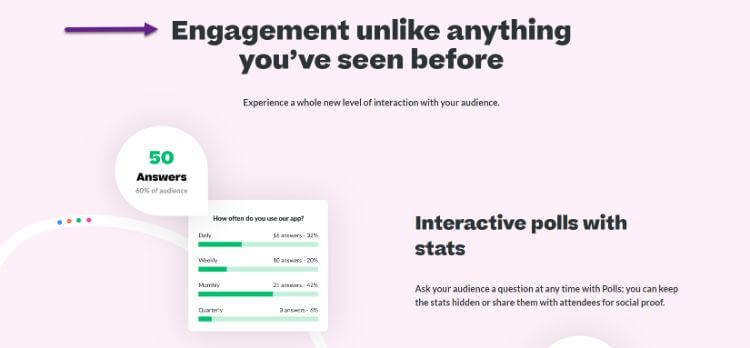
- Automatic, cloud-based webinar events and recordings.
- Chats, polls, handouts, and a great waiting room experience.
- Offers built-in analytics and insights.
- It can be easily integrated with other marketing tools.
- Email automation and event reminders.
User Experience:
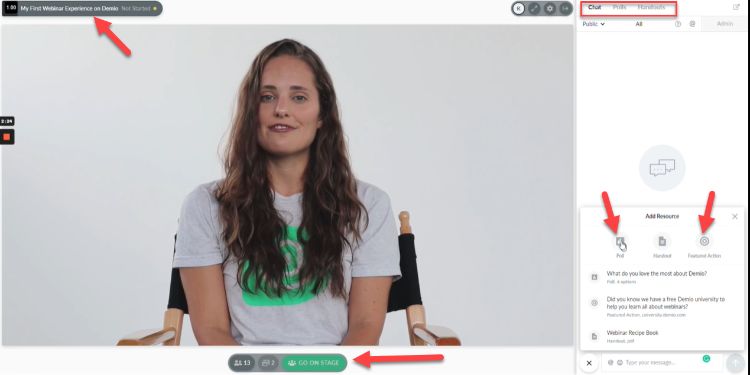
Things are super organized when it comes to the user experience on Demio.
With a chat feature on the right-hand stage of your screen, you’ll see all the comments, answer using reactions, or type in an answer in the chat.
There’s also an “answer live” button which will pipe the question or comment into the chat and send it to everyone in real-time.
Furthermore, the speaker preview at the top of the screen allows viewers to see the speakers as they present.
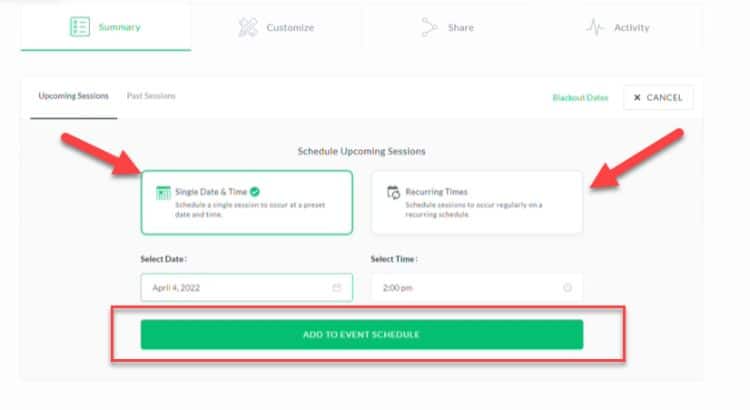
PRICING PACKAGES:
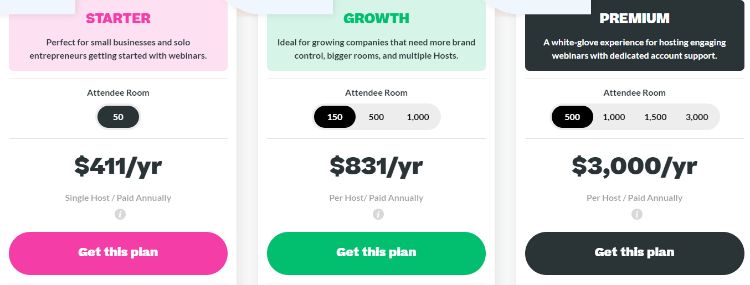
Demio provides a free webinar software trial for 14 days, allowing you to test all its features. Here’s a breakdown of their paid plans.
- Starter Plan: $411 per year for a 50-person webinar room
- Growth Plan: $831 per year for a 150-person room
- Premium Plan: $3000 per year for a 500-person room.
What I Like / Dislike About Demio:
Like:
- Easy to use interface with a lot of attention given to the items that matter.
- Customization when running events is a priority for the team.
- Excellent customer service when needed.
Dislike:
- Integration with other software does sometimes cause bugs.
- The browser experience when new participants join is occasionally lacking, causing these participants to drop from the webinar.
Product Updates:
- A formal queue system is now part of Demio’s experience. If a room is complete, people will be automatically added to the bottom of the queue instead of being turned away.
- Demio and Hubspot can now be connected to send all your new leads to Hubspot.
Here’s my full Demio review if you want to know more about this platform.
If you want to run more effective webinars with built-in marketing tools and no downloads required, give Demio a try.
Use promo code ADAMENFROY25 to receive 25% off your first month on all monthly plans.
2. Livestorm.
Best Webinar Software (Free – $99/month).

Adam’s Take
If your focus is on connecting and engaging your audience, then I believe Livestorm is the platform for you. Making it easy to connect yet providing powerful engagement features, Livestorm also excels when it comes to online collaboration. If you want to manage your online event from start to finish, I advise using Livestorm as your webinar software.
Best For
Audience Engagement
Price
Free – $99/mo
Annual Discount
Yes – Save 10%
Promotion
Sign Up For Free
Livestorm is an excellent webinar tool for product demos and sales.
Their software works on any browser without any restrictions on the size of your webinar.
It can also be accessed from any device, including PCs, laptops, tablets, and mobile phones.
With their tool, you can run live, on-demand, or automated webinars. Webinars are great for live events like product demos, customer training, and other technical sales topics.
Their on-demand and automated webinars work best for online courses, employee onboarding, and video podcast interviews.
An area where it stands out is email logistics, where you can send promotional emails, automate those emails, check email status, and add a touch of personalization.
This webinar tool takes your data security seriously and is 100% GDPR compliant.
Livestorm also focuses on customer engagement with activities like polling, Q&A sessions, and upvotes.
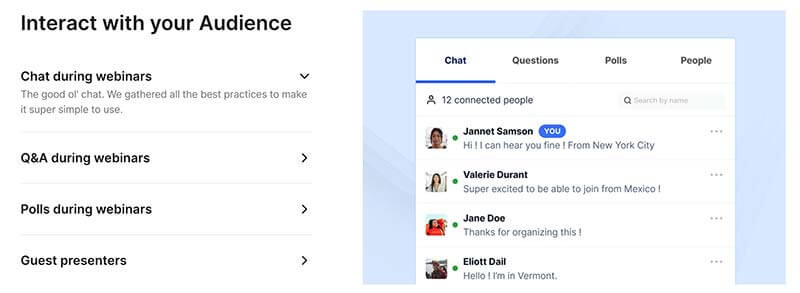
They also make it easy for people to join your webinars.
They don’t need to register or create a specific account – they can join with one click and an internet connection.
Key Features:
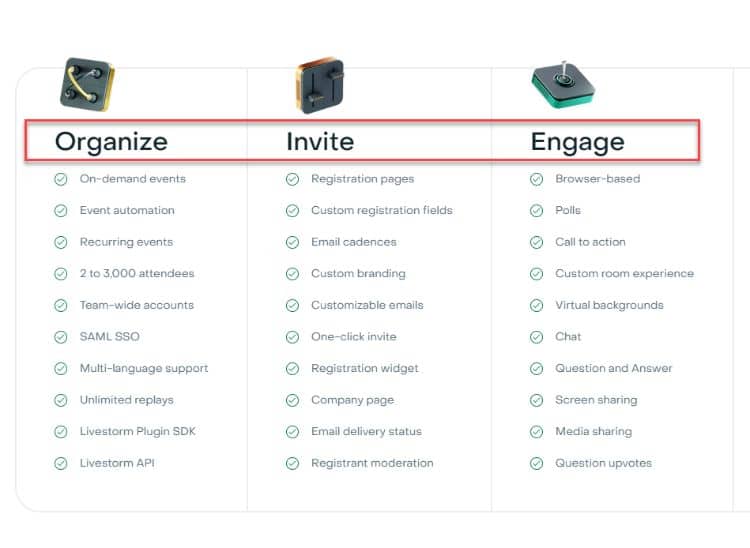
- Provides access to highly adaptable webinar themes with an easy set-up process.
- Offers interactive chats with polls, questions, chat, and more for a better customer experience.
- Great for product demos and 1:1 meetings to qualify leads and improve your sales process.
- Integrate and analyze webinars and video meetings.
- It provides a high level of automation with webinar sequences.
- Offers comprehensive, multi-language customer support.
- It has features like a one-click invitation, screen-sharing, embedded registration forms, and more.
- Livesorm offers a freemium plan with essential features.
- Provides detailed attendance analytics, replay analytics, source tracking, and participation report.
- Unlimited recording storage.
- It allows you to export your data as CSV or XLS.
- It enables you to use Zapier and integrates with more than 1,000 apps.
- Display in-webinar CTAs to influence viewers to act.
User Experience:

One thing I like about Livestorm is that if there are any issues with your audio and video, there is a five-step process to help you troubleshoot the problem.
Compared to other software, you will not be left in the dark regarding potential webinar issues that happen now and then with all software.
There is also a manual compatibility mode that you can use if you have any issues with the webinar software and your specific internet browser.
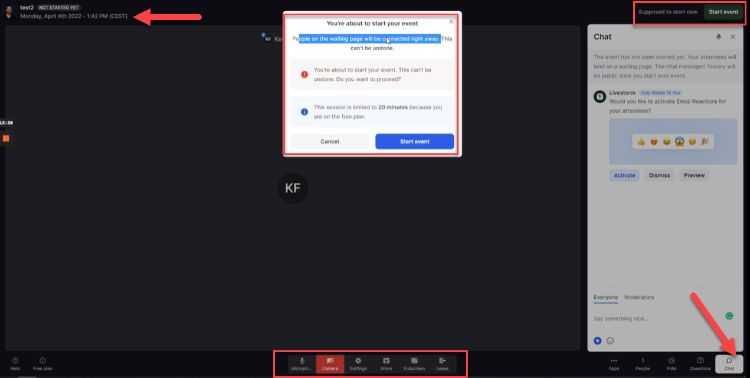
Pricing Plans:
Livestorm offers three pricing plans.

Free: The first plan is freemium and comes with essential features like unlimited on-demand webinars, meetings, etc.
Pro: This plan costs $79/host per month and has a 4-hour limit per webinar.
Business: This is a quote-based plan.
Enterprise: There’s also the ‘Enterprise’ plan. It offers features like managing multiple workspaces with unified billing, premium training, and SLA availability.
Here, you get a personalized quote based on your requirements.
Overall, they are a high-quality tool, and their live features are great for product demos and sales training; they’re number one on my list for a reason.
What I Like / Dislike About Livestorm:
Like:
- The video quality during the webinar is top-notch
- The ease of use is compared to using PowerPoint.
- New tools are constantly being introduced.
Dislike:
- Virtual background detection needs work to be as good as other software.
- The system doesn’t ‘remember’ the logo and cover image, which needs to be readded for each webinar you run.
Product Updates:
- Partner integration with Gusto (payroll solution) means that when a new employee joins your company on Gusto, Livestorm will automatically create a new account!
- Marketo is a native integration on Livestorm, which will help with your marketing automation and lead management.
3. WebinarGeek.
Best for Full Custom Branding.

Adam’s Take
If you want a webinar platform that’s easy to use and helps you create, host, market, and automate your webinars easily, WebinarGeek is the perfect solution. With WebinarGeek, you can quickly create and launch a fully branded webinar experience. You can also customize the look and feel of your webinars as you see fit.
Best For
Full Custom Branding
Price
$19+/mo
Annual Discount
Yes – Save 20%
Promotion
14 days free
With WebinarGeek, you can host interactive webinars that allow participants to quickly engage and interact with one another.
You can fully brand each webinar with your logo, color scheme, and brand-specific visuals.
WebinarGeek also integrates with over as many as 5,000 software applications and services.
These include HubSpot, Stripe, and many more.
Whether you want to share presentations, videos, or your screen, WebinarGeek has the features you need to deliver an excellent webinar.
Key Features:
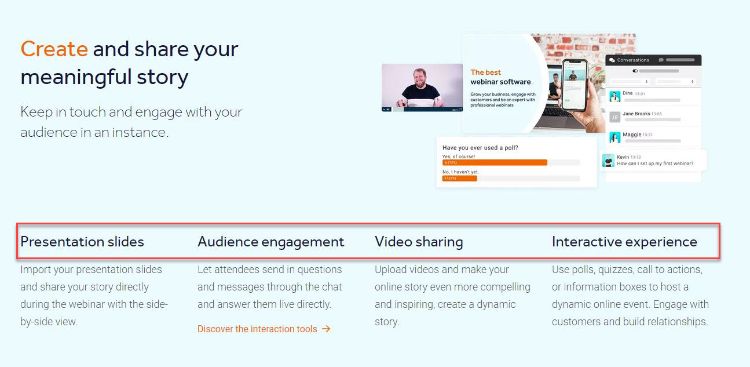
- Each webinar can be fully branded with your corporate identity.
- You can run paid webinars with various monetization options such as subscriptions, tickets, and more.
- Live, automated, on-Demand, and hybrid webinars are all possible with WebinarGeek.
- You can automate emails and registration forms to make your webinars run smoothly and hassle-free.
- Audio and video broadcasting is of high quality, while the streaming features ensure that no viewers experience lag or buffering.
- WebinarGeek is also 100% GDPR compliant, keeping your data and your customer’s data safe and secure.
User Experience:
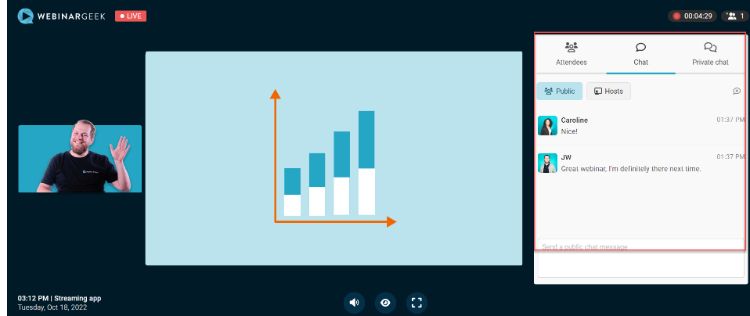
With WebinarGeek’s drag & drop editors, even those with no technical skills can create a professional-looking webinar.
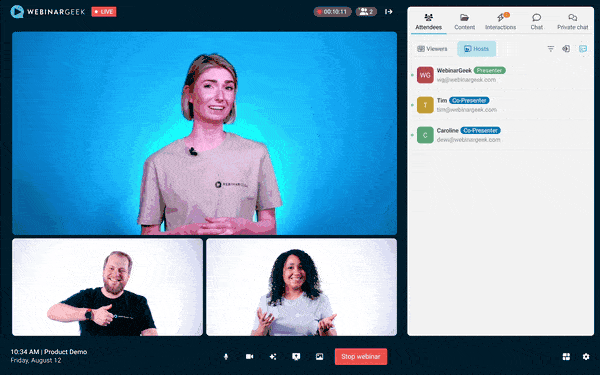
Pricing Packages
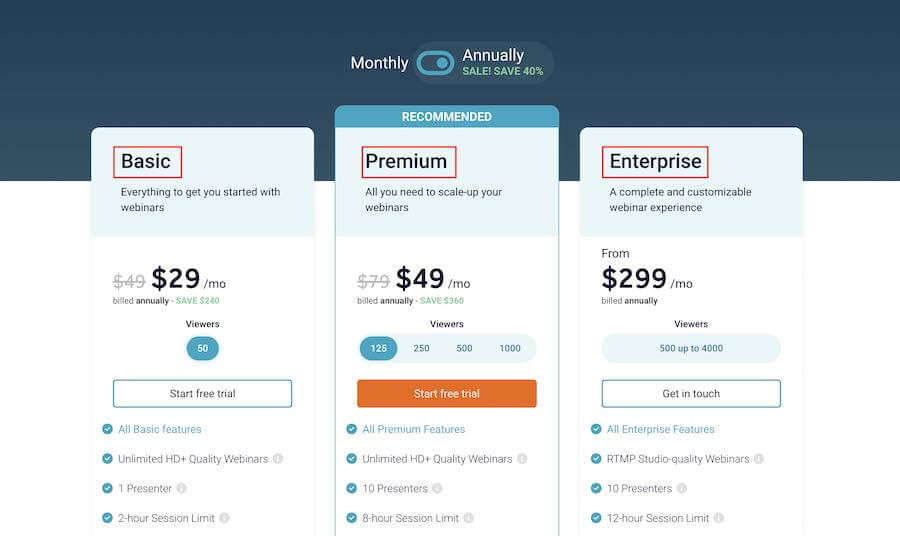
The pricing is based on the number of viewers you will be hosting.
For up to 100 viewers, the cost is as follows:
- Basic: $29 per month
- Premium: $49 per month
- Enterprise: $299 per month
What I Like / Dislike About WebinarGeek:
Like:
- WebinarGeek always emphasizes simplifying the process of hosting a webinar, and their customer service is top-notch.
- Viewers don’t have to install any software; they can watch directly from their browser window on any device.
Dislike:
- It’s great that you can send emails to viewers and non-viewers. However, there doesn’t seem to be a way to know who opened the emails.
Product Updates:
- WebinarGeek interface in German has been added.
- A more clear registration page enables you to set up better webinars.
- The API has been improved, allowing for more filtering and more details.
4. Zoho Meeting.
Best for a wide range of webinar and video conferencing formats
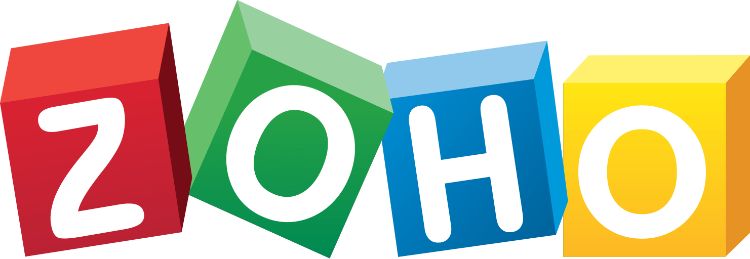
Adam’s Take
Having standard industrial security when hosting a webinar is helpful in many situations. If you want peace of mind regarding your webinar data while still allowing you to run a webinar the way you want, I would tell you to go for Zoho Meeting. With enterprise-level experience provided on all their plans, you can’t go wrong with this software.
Best For
Educating a Global Audience
Price
Free – $16 /month
Annual Discount
Yes – Save 15%
Promotion
Get Started For Free
Zoho Meeting is one of my absolute favorite webinar tools! It is perfect for anyone who wants one platform that can be used for marketing webinars, internal team webinars, group web conferencing, and even one on one meetings. It is so simple to use and is trusted by tens of thousands of customers worldwide.
Zoho makes world-class products for every aspect of your business. From marketing and CRM tools to customer service and finance tools, Zoho has you covered.
Key Features
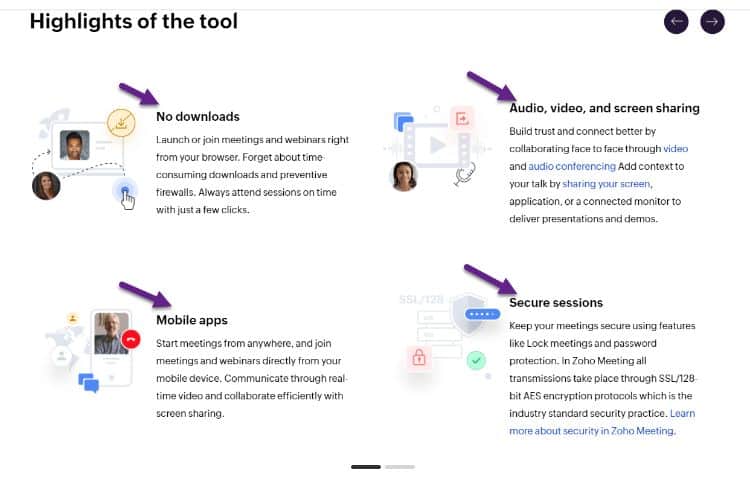
- Ability to join and launch features right from your browser without any downloads.
- Mobile application allowing attendees to join from any device.
- High-quality recording options for audio, video, and screen sharing.
- Sync meetings with popular calendar apps, so your attendees don’t miss your webinars.
- Advanced webinar settings give complete control of your webinar presentation.
- Customizable registration forms allow you to make the perfect form for your business.
- And a TON more!
User Experience:
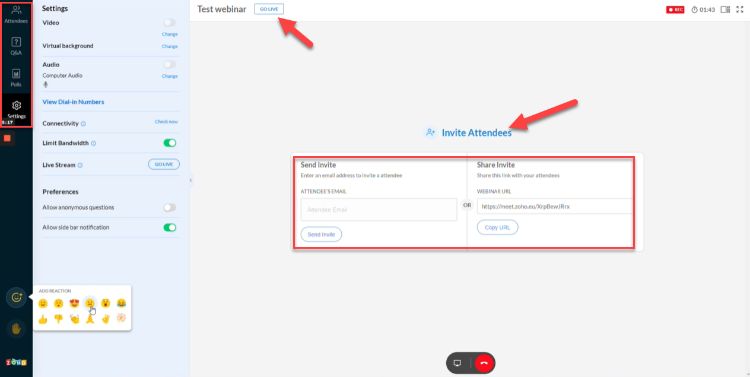
The ease of use by which you can share your webinar link with participants is beneficial.
You can either share the meeting link or even invite participants directly by inputting their email.
You can also give any of your participants control, mute their audio or even remove them if you want to.
The main controls on the left-hand side of the screen allow you to share your screen, lock your meeting, or even exit – all presented in an easy-to-understand menu.
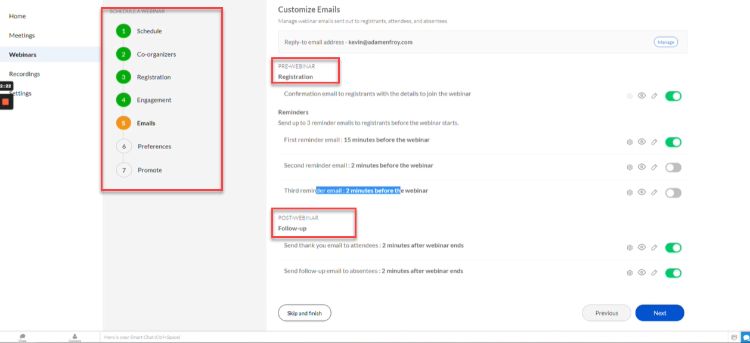
Pricing Packages
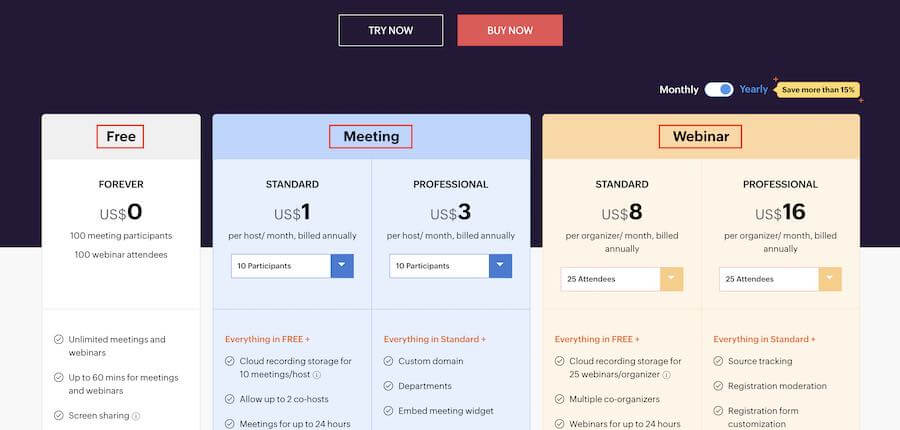
Zoho Meeting’s pricing is affordable and scalable for your business.
It starts at $16 per month for up to 25 attendees and scales to over 1,000 attendees for only $200 per month!
Whether you pay $16 or $200 per month, you can access 100% of the premium features.
If that wasn’t already too good to be true, Zoho offers a no credit card required 14-day free trial.
Zoho also offers an entirely free plan with limited features and attendees, which is another perfect option for anyone looking to try out a few different webinar platforms.
What I Like / Dislike About Zoho Meeting:
Like:
- Zoho Meeting works well on every browser, so there’s no need to download additional software
- Very user-friendly and easy to set up
- Scheduling future webinars is a piece of cake
Dislike:
- Key features such as video recording are not available
- Not suitable for larger group meetings
- Sometimes, disconnections and webinar slowdowns do occur
- You need a high-speed connection to ensure that everything works as it should
Product Updates:
- One can create ‘departments’ within their Zoho Meeting account. This is an excellent feature if team management is essential to you.
- You can now open and share PDFs directly during a webinar without having to screen share your entire screen. You can keep your participants engaged by only showing the proper document on screen.
5. WebinarJam.
Best for Selling Products with In-Webinar Pop-Ups (14-Day Trial for $1).

Adam’s Take
The ability to run call-to-action ads and make offers as you’re live during a webinar can significantly increase your bottom line. While this wasn’t possible a few years back, WebinarJam is a platform that offers this live offer feature. Check out this software if you plan to sell live during your event.
Best For
Making Active Offers
Price
$39/mo – $379/mo
Annual Discount
No
Promotion
Get Started For $1
WebinarJam is #5 on my list of the best webinar software currently available. If you have little to no technical knowledge regarding how to set up a webinar, then this easy-to-use webinar platform has you covered.
Additionally, it allows you to stream directly to a YouTube page and have a secure, password-protected meeting with your target audience online.
It also offers some distinct advantages over other tools, such as:
- Providing pop-ups to your audience during the webinar session itself, which allows them to buy your product or service right from the webinar
- Offering excellent two-way communication via advanced Live Chat, which pulls a video of the participant for 1:1 video communication
WebinarJam employs a unique and distinct Broadcast Distribution Technology, which creates a universal signal.
Besides, it uses all the latest technology, like RTMP, WebRTC, HLS, and Flash, which makes it compatible with almost all web browsers and devices.
You also get other impressive features, such as HD video, customer-facing interfaces, user-friendly dashboards, and the option of multiple presenters.
Every recording is automatically recorded so the replay can be sent to your audience. Additionally, the tool is straightforward, and they have training videos to help every step of the way.
You can read my full review of WebinarJam here.
KEY FEATURES:
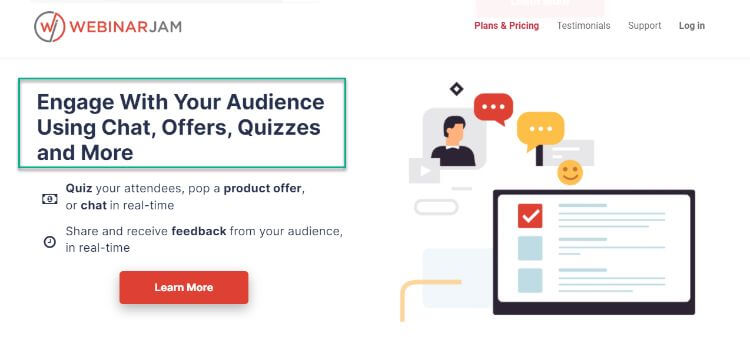
- Automatic recording.
- It offers excellent customer support.
- Built-in autoresponder.
- Social media integrations.
- Has the ability to handle multiple attendants easily.
- Compatibility with various browsers and operating systems.
- It allows you to incorporate polls and surveys with your webinar.
- Extremely easy to use, with user-friendly dashboards and interfaces.
- Quick setup process; it takes about 60 seconds to start working.
User Experience:
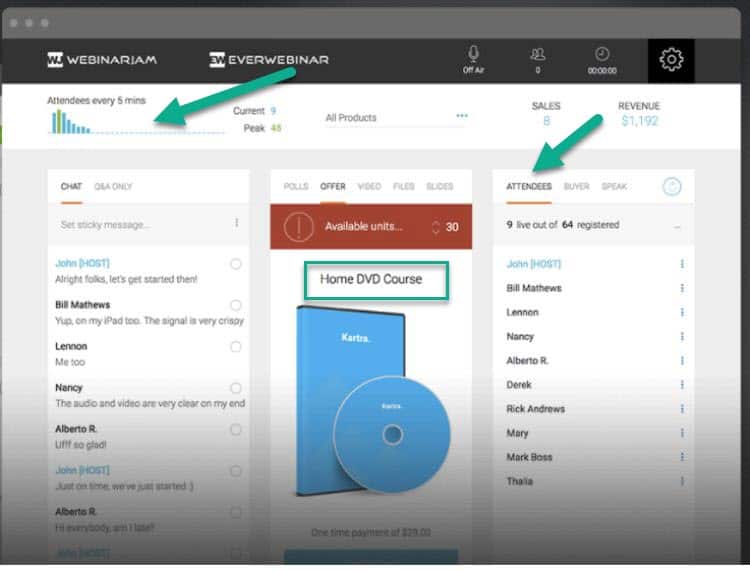
Regarding the user experience, WebinarJam is very intuitive and packs a lot of information in one interface.
With an attendance chart that updates every so often, you’ll be able to see in real-time how many people are logged in, along with the number of people at peak.
You’ll also be able to interact with these live viewers with a built-in chat.
If you want to present your offers live during the webinar, you can click on the “offer” button.
You’ll preview the offer title and set the image that people will see, along with other essential information about your offer.
You can also see the chat as it’s happening, with the ability to set sticky chat notifications and messages.
PRICING PACKAGES:
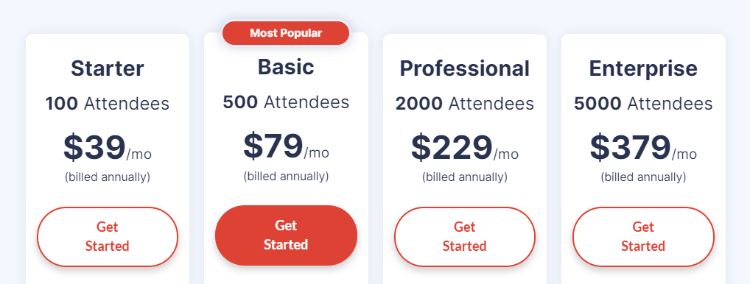
- Starter Plan: $39/ month (billed annually). Up to 100 Attendees
- Basic Plan: $79/ month (billed annually). Up to 500 Attendees
- Professional Plan: $229/ month (billed annually). Up to 2000 Attendees
- Enterprise Plan: $379/ month (billed annually). Up to 5000 Attendees
What I Like / Dislike About WebinarJam:
Like:
- Appealing design and user interface make this a great product
- There are a ton of features you can use to increase customer engagement during webinars
- Great video and presentation playback system
Dislike:
- Customer support is known sometimes to be unresponsive to user questions.
- Compatibility issues with various devices make this unusable for some attendees.
- There are no breakout rooms if you want to divide your attendees into smaller groups.
Product Updates:
- You can now open and share PDFs directly during a webinar without having to screen share your entire screen. You can keep your participants engaged by only showing the proper document on screen.
You can get started with a 14-day trial of WebinarJam for $1 to test its features. Go to their pricing page and hover your mouse near the top of the screen to fire their exit-intent pop-up with this offer.
6. WebinarNinja.
Best Platform for High-End Coaches ($29/month).
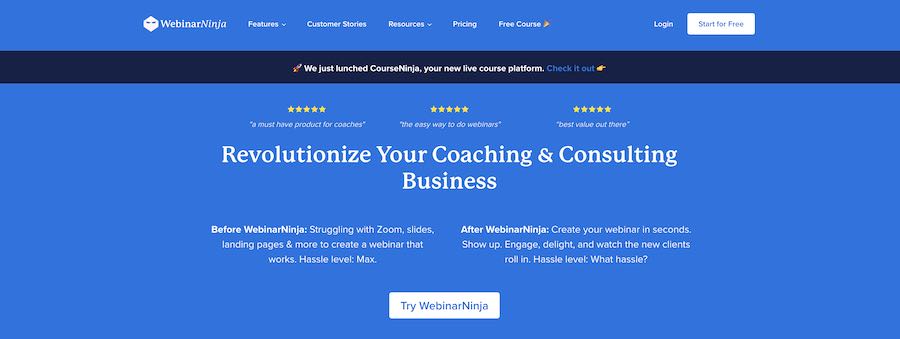
WebinarNinja is a powerful, all-in-one solution trusted by major brands like AppSumo, Podia, Printful, and more. They are one of the most accessible tools, with out-of-the-box thank you and sign-up pages, allowing you to create a webinar in under a minute.
WebinarNinja allows you to create four different types of webinars:
- Live – broadcasted with a live host for audience interaction.
- Automated – recorded webinars that run at certain times or on-demand.
- Series – a group of several webinars.
- Hybrid – a combination of live and recorded videos.
Key Features:
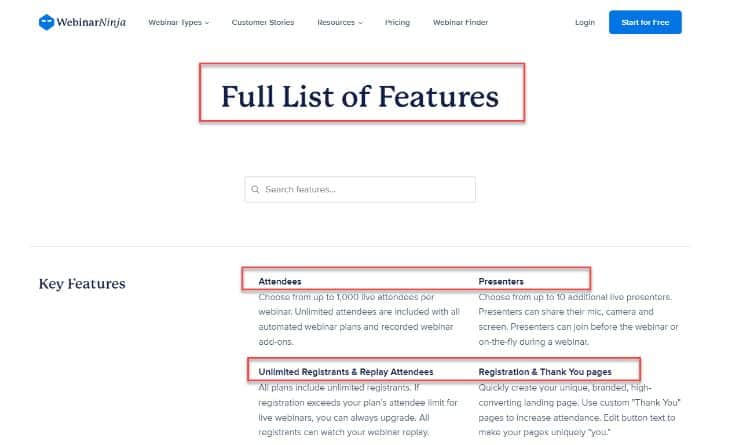
- Lightning-fast live chat.
- Instant screen sharing.
- Run multiple polls before, during, and after the webinar.
- Timed offers to display at any time during your webinar.
- Email automation and drip campaigns.
- High-converting, custom registration landing pages.
- Analytics dashboard with the ability to export data.
- Integrations with 1,000+ apps with Zapier.
User Experience:
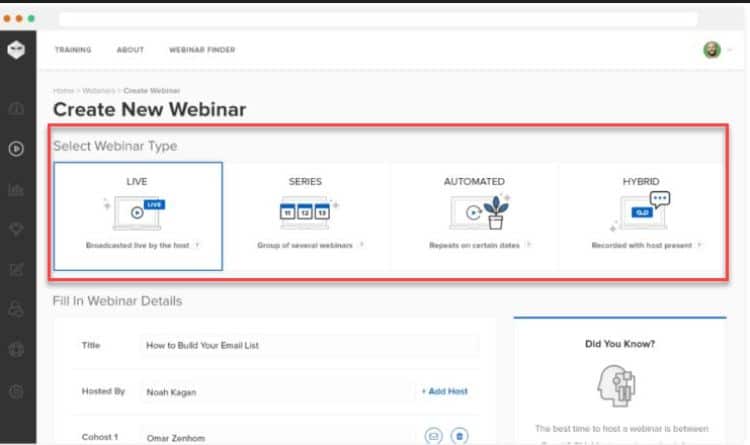
WebinarNinja makes it easy to schedule various types of webinars.
Whether a live webinar, series, automated webinar, or even a hybrid, big clear buttons help you get started in minutes.
Simply choose your webinar type, date, and time and start promoting to your audience.
Pricing:
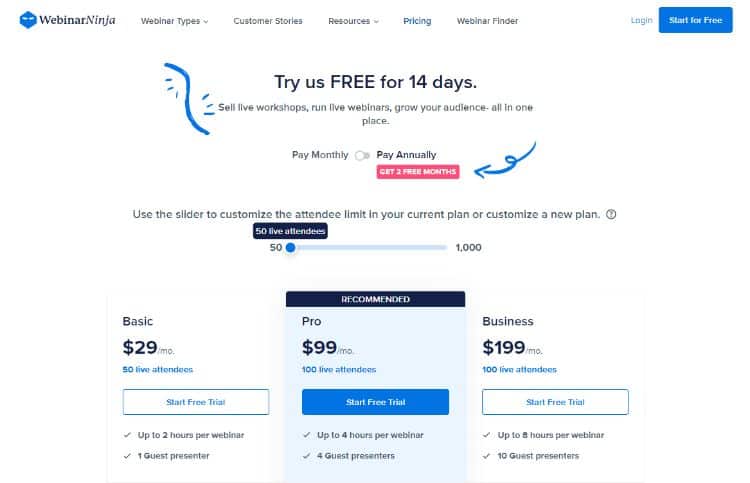
WebinarNinja comes with a 14-day free trial to test out its features. It also features four paid plans:
- Its Basic Plan is $29/month and works well for users that only require 50 webinar viewers.
- Next, their most popular Pro Plan is $99/month and adds another 100 attendees.
- They also have a Plus Plan at $199/month, also for 100 attendees but providing more advanced features.
Overall, WebinarNinja is an excellent tool for those looking for advanced features and the ability to create webinars quickly.
What I Like / Dislike About WebinarNinja:
Like:
- Setting up a webinar is easy and can be done without much effort
- Various webinar types make it easy to set up the right webinar for your needs.
Dislike:
- Limited integration with other tools that might be used in business.
Product Updates:
- New Media Library helps you stay on top of your media files
- Additional presenters were added to all plans.
7. GoToWebinar.
Best Web Conferencing Software for Large Organizations ($89/month).
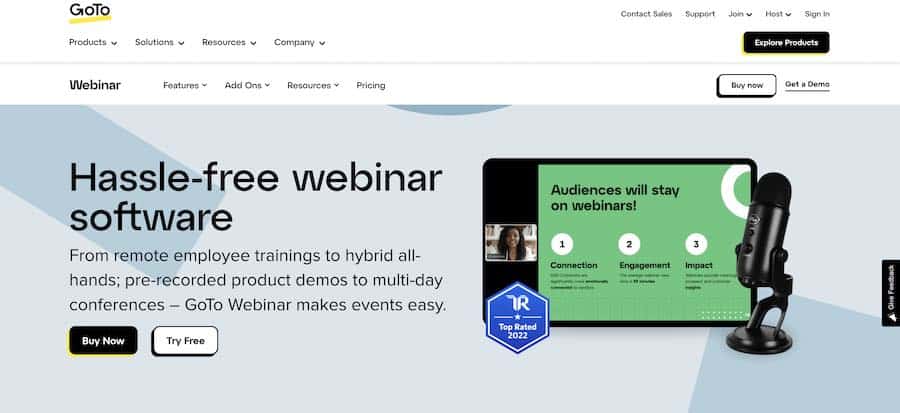
The following webinar software on my list is GoToWebinar.
With GoToWebinar, you don’t have to worry about the clutter and confusion that comes with organizing your webinar and can focus on reaching more people and growing your business.
All you do is choose the date you want to host your webinar, and it takes care of everything else.
It also exposes you to various features to improve your webinar experience, ranging from flexible scheduling to the entire event management process.
You can also access several in-built webinar templates that provide the ultimate business environment.
Moreover, with impressive features such as automated email reminders, customizable webinar invitations, and a highly converting registration page, you can promote your upcoming event and drive massive traffic.
Other features include in-built polls and surveys, automatic webinar recordings, and more.
KEY FEATURES:
- Pre-recorded events.
- Robust analytics.
- HD video quality.
- 24/7 customer support.
- Integrations with GoToMeeting.
- In-built polls and surveys to engage your audience.
- Automatic recording, which can then be shared online.
- Seamless integration with tools such as Zapier, Salesforce, Unbounce, etc.
- Source tracking to discover which channel resulted in the maximum webinar signups.
PRICING PACKAGES:
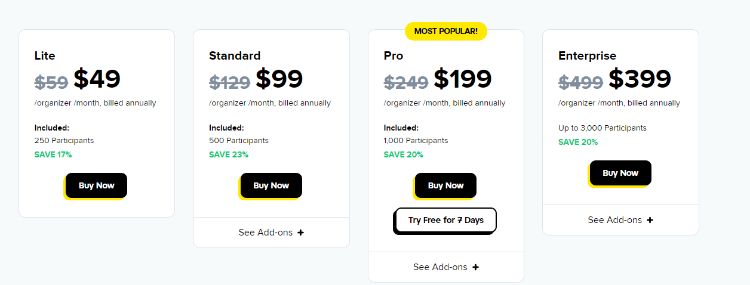
The Lite plan costs $49 per month for 250 participants, the Stanard costs $99 per month for 500 participants, the Pro costs $199 per month for 1,000 people, and the Enterprise costs $399 for 3000 participants.
CONS:
- The Starter plan limits the attendance count to 100.
- Comes at a higher price than some other tools on this list.
8. LiveWebinar.
Best for Live Streaming (Free – $95.20/month)
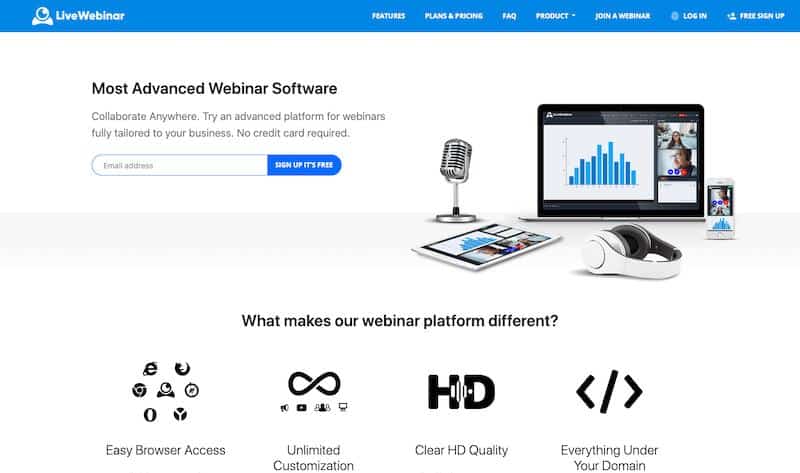
LiveWebinar is a cloud-based webinar tool that lets you host webinars, share screens, stream live videos, record your screen, use social media broadcasting, and more.
It has over 42 data centers, over 99% SLA, and can host over 1000 participants.
You can join and conduct webinars without installing or downloading their application – directly from internet browsers like Chrome, Opera, Firefox, etc.
Plus, the ability to embed webinars into your website helps you conduct or display webinars straight to your site visitors.
The tool integrates with several platforms like emails, phone, and text messages to help you invite members to your upcoming webinar.
The webinar platform helps you stream live on all social media platforms like Facebook, Youtube, Vimeo, etc.
You can even connect it and work from all devices, including Smart TVs, PCs, and mobile phones.
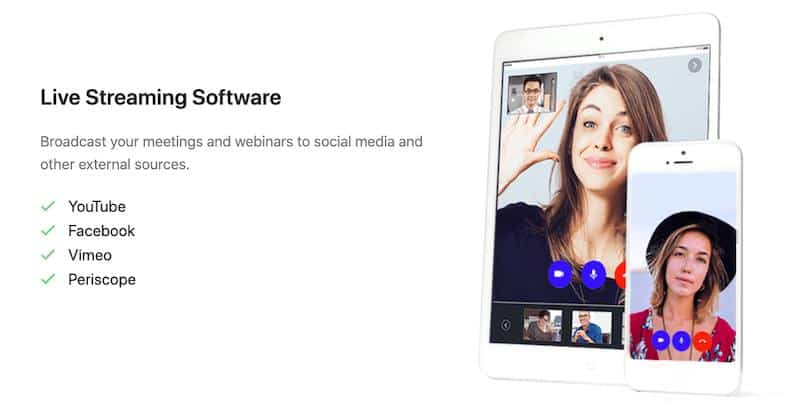
LiveWebinar allows you to record the entire webinar or some webinars in HD quality.
You can then share it with whoever you want or embed it on any platform you like, including your site or other external platforms.
You can also share your desktop screen during live streams and webinars in real time with a single click.
It also lets you monitor audience engagement analytics and create and share advanced reports and statistics.
You can chat with your attendees and conduct polls and surveys to engage your audience while conducting the webinar.
There’s also an option to include call-to-action buttons to encourage participants to take action and convert more leads.
Assigning roles to different employees or colleagues also come in handy. You can manage various tasks during the webinar or live streaming.
Additionally, you can customize your webinars according to your choice with different templates, colors, and branding elements.
Integrations include all the primary marketing automation tools like MailChimp, Campaign Monitor, FreshMail, Slack, etc.
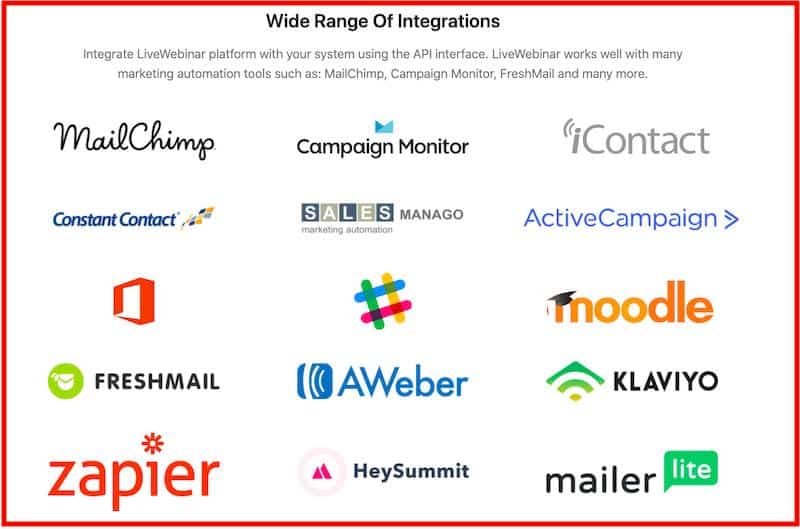
Key Features:
- The WhiteBoard feature helps you express your ideas by drawing on documents and videos. You can invite your viewers to draw as well.
- Add Prezi forms to your Webinars.
- Split your main room into smaller breakout rooms, even during live meetings.
- It lets you host up to 1000 attendees.
- There’s a freemium for up to 5 attendees.
- All the pricing plans come with a 14-days free trial.
- You can embed Ads-banner into your webinars.
- Translates chats in real-time into the language you prefer.
- You can include tests, surveys, and polls while conducting your webinar.
- Play your YouTube video in your webinar rooms.
Pricing:
LiveWebinar provides the following four pricing plans:
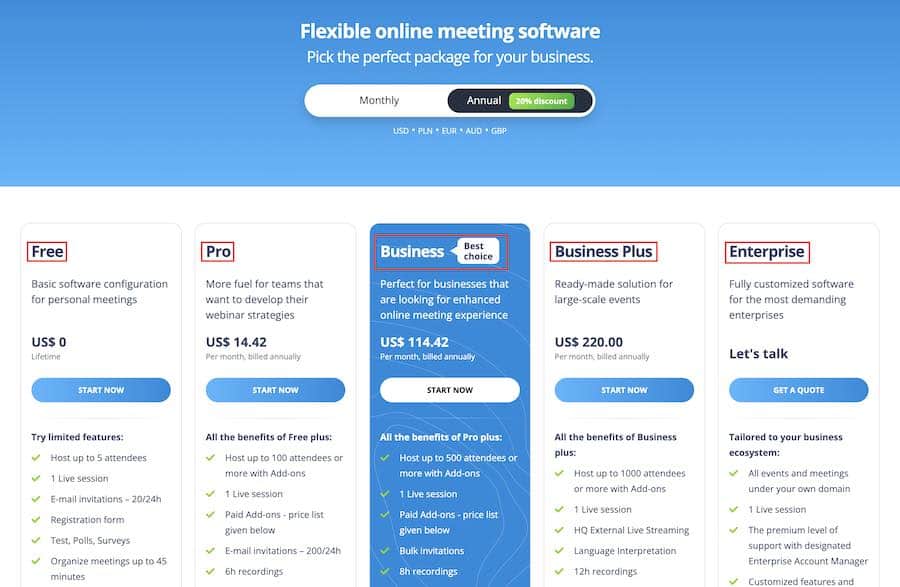
- Free: $0 per month (for up to 5 attendees)
- Pro: $14.42 per month (for up to 100 attendees)
- Business: $114.42 per month (for up to 500 attendees)
- Business Plus: $220 per month (for up to 1000 attendees)
- Enterprise: Custom pricing (All events under your domain)
All plans include features like Prezi presentations, the ability to add tests, polls & surveys, email invitations, whiteboard, screen-sharing, and more.
9. EverWebinar.
Best Automation Features (60-Day Trial for $1).

Touted as the “most powerful automated webinar platform,” EverWebinar is one of the most popular tools on this list.
It is built with direct integration to WebinarJam, although the parent company sells them separately or in a bundle.
Some features include fully automated customer-activity-based email connections, keeping users in the loop, and complete set in under three minutes for WebinarJam users.
Also, it records the webinars automatically so the user can replay them for potential leads.
EverWebinar suits small and medium businesses looking to generate leads and boost their sales using Webinars.
KEY FEATURES:
- One-click platform swap between WebinarJam and EverWebinar.
- It allows you to fake your audience count.
- Performance stats in real-time.
- Convert past live events into evergreen webinars.
- Just-in-time webinars start right away upon registration.
- An advanced scheduling system that helps block out unavailable dates.
- Time-zone auto-detection for the ease of users all over the globe.
- Unlimited free hosting via reliable, cloud-based servers.
PRICING PACKAGES:

It costs $499 (billed annually) or $874 billed every two years.
Its features and the partnership with WebinarJam make it worthwhile.
10. BlueJeans.
Best for Large Virtual Events and Townhalls ($83/month).
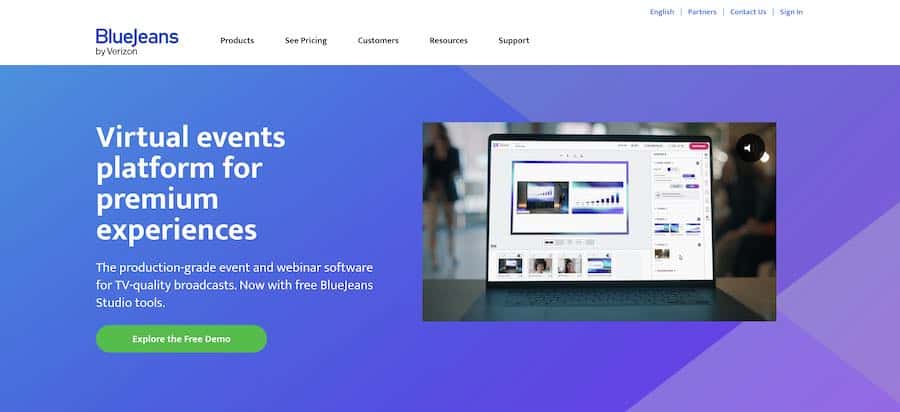
BlueJeans is a video conferencing tool that has four different products, one being BlueJeans Events.
This virtual event tool can host events for large global audiences, like live streams, interactive events, and town halls.
This production-grade platform can host up to 50,000 attendees and provides unique content experiences like Q and As, immersive video, and live polling.
When I worked in the tech industry, this tool would have been perfect for running our company’s weekly employee all-hands meetings.
BlueJeans Events provides a live, interactive open forum where ideas can be exchanged and huge audiences can share information.
Here’s how it works:
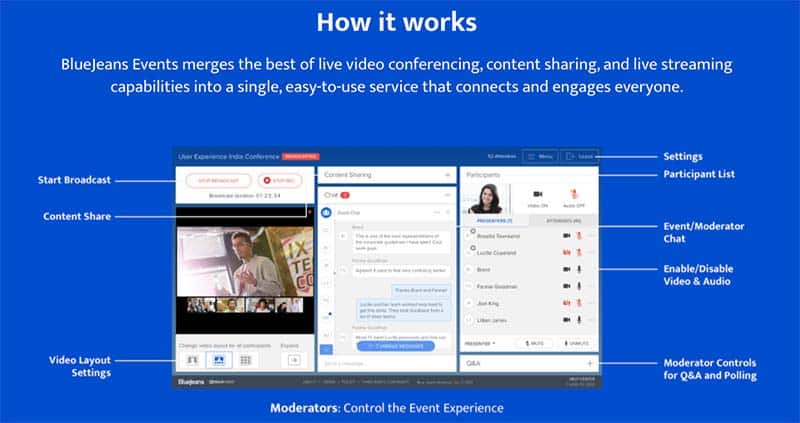
Within three interactive screens, you can start your broadcast, view the participant list, enable and disable audio, and have full moderator controls for Q and A and polling.
KEY FEATURES:
- Host worldwide events with 50,000 attendees and 150 presenters.
- Event cloud recording.
- Easy moderator controls to manage the event.
- Works from any device without downloading an app.
- Can live stream to Facebook Live.
- Post-event analytics reports.
- A/V equipment recommendations and specs.
- 24/7 premium support.
PRICING:
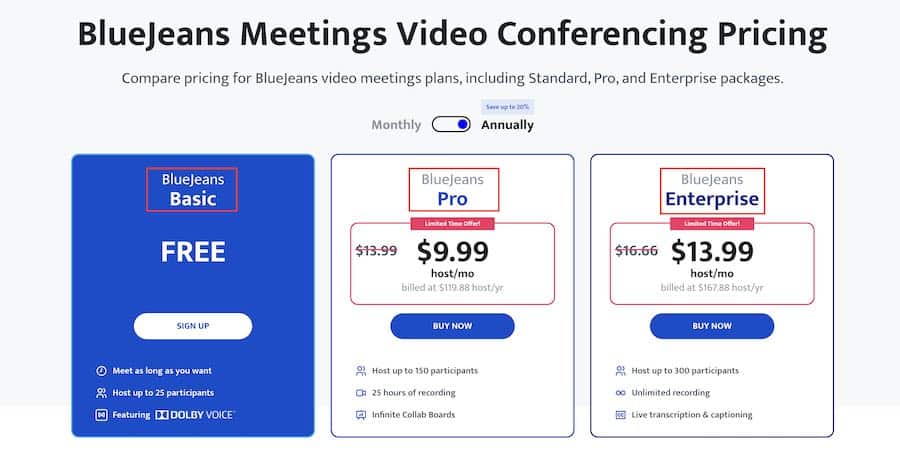
BlueJeans Events starts at $9.99 per month (when paid annually). This option provides up to 100 attendees, engagement features, and a maximum webinar duration of two hours.
If you’re planning to host significant events, town halls, and all-hands meetings for a global audience, BlueJeans is your top pick.
11. My Own Conference.
Great for Scheduling Multiple-Webinars to Small Groups (Free – $30/month and up).
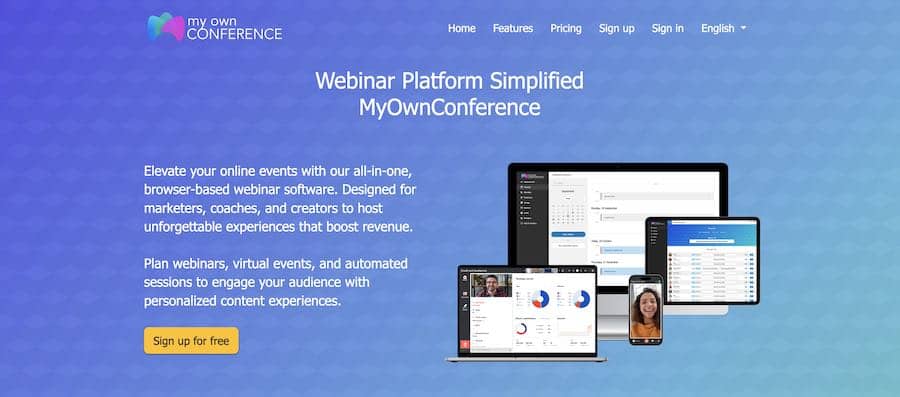
My Own Conference is a webinar tool that helps you connect with your audience before, during, and after the webinar.
Its standout features include its helpful schedule view, which lets you see multiple webinars in one place, and its “always-on” webinar room.
While their tool is free for up to 20 attendees, one drawback is that it gets costly if you need more attendees. For example, if you want up to 5,000 attendees, you have to pay $1,920 per month.
I recommend this software if you’re looking for a cheap team collaboration tool to hold multiple webinars to a small audience.
KEY FEATURES:
- Record your webinars in full HD and send them to attendees.
- Video conferencing and screen-sharing features for teams.
- Instant messaging capabilities during webinars.
- No download is required for attendees.
- You can share videos and YouTube videos during your broadcast.
- Online quizzes can test your audience’s knowledge.
- White-label solutions for agencies and brands.
- Sixteen languages supported.
PRICING:
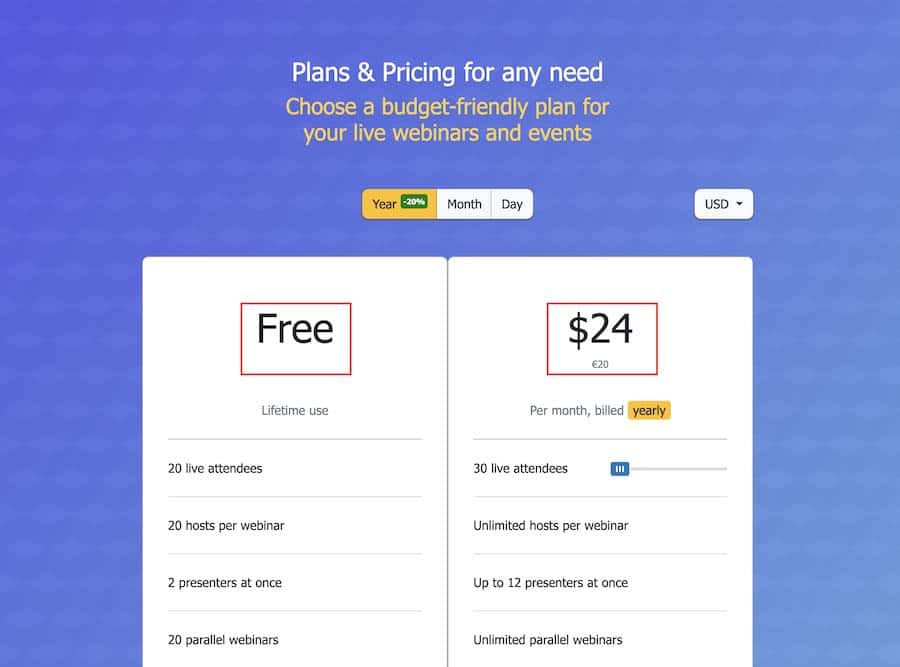
My Own Conference is free for up to 20 attendees and three broadcasters. The free plan also includes 500 MB of storage and standard HD quality.
Paid plans scale based on attendee counts and provide access to more storage and full HD videos. For example, 60 attendees are $29/month, 150 are $48/month, and 1,000 is $240/month.
Get started with My Own Conference for free.
12. EasyWebinar.
Most User-Friendly Webinar Software ($59/month).
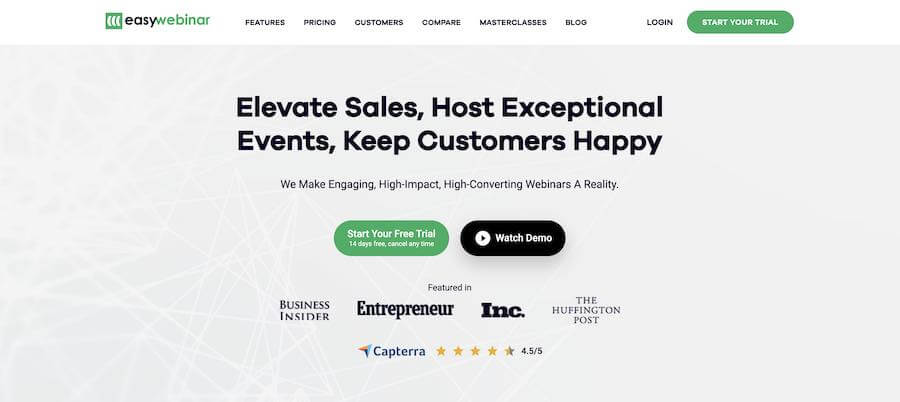
EasyWebinar is the only online software platform that has successfully and seamlessly managed to integrate webinar technology with marketing strategy.
Moreover, it provides an all-in-one solution for both live and automated webinars.
The webinar software offers many other features, including a multi-presenter option, integration with popular email marketing software, shopping carts, and lead-generation tools.
KEY FEATURES:
- Screen-sharing options, HD video, and interactive live chat.
- Allows up to 100 attendees even in the basic plan.
- Unlimited live viewers using YouTube Live Integration.
- Robust chat features and a mobile app are available.
- WordPress integration.
- In-built analytics suite.
- It allows integration with popular tools like MailChimp, GetResponse, etc.
PACKAGES:
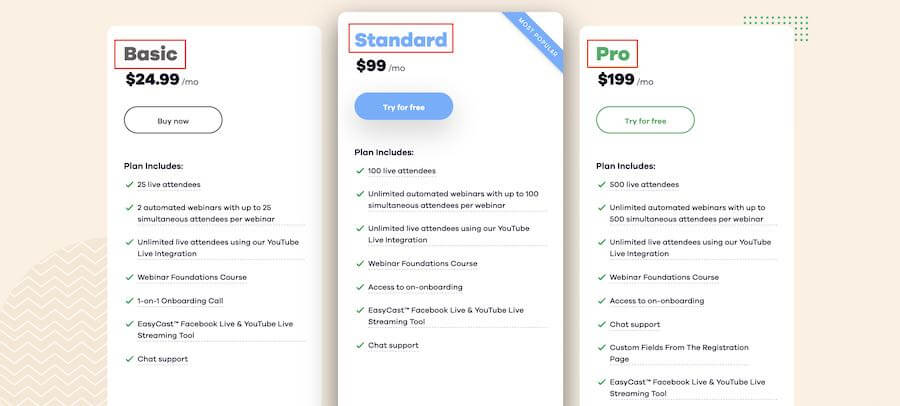
The Basic plan begins at $24.99 per month, the Standard plan at $99 per month, and the Pro plan is $199 per month.
If you have over 10,000 attendees, then you can get in touch with them for quote-based pricing.
13. ClickMeeting.
Best Tool for Education Features ($25/month).
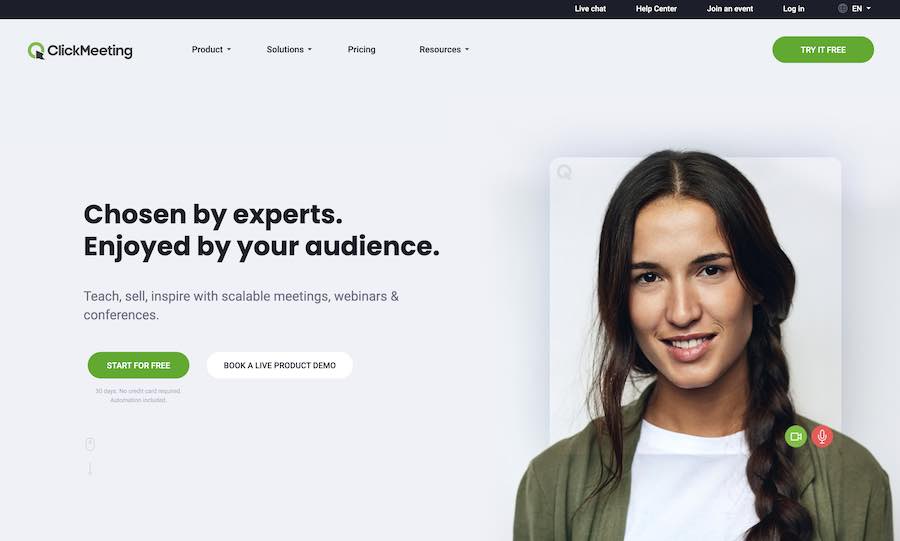
ClickMeeting is one of the most popular webinar software platforms in this list, with an impressive and user-friendly interface.
ClickMeeting makes reaching out to your customers easier for training, product sales and marketing, and other aspects.
It is a well-integrated, intuitive platform that provides options for automated webinars and customized invites.
Best suited for small and medium-sized businesses, ClickMeeting provides clear instructions to set up the event effortlessly without worrying over any technical stuff.
It also offers analytical insights regarding past webinars and the audience of the upcoming webinar.
KEY FEATURES:
- Offers polls and surveys for feedback.
- Chat options and interactive sessions.
- It can be connected to Facebook and YouTube to enhance engagement.
- You can record the entire audio and video of the live sessions, which are then stored in clouds and can be downloaded easily.
- Multiple presenters can present with HD video.
PRICING PACKAGES:

ClickMeeting’s rates start at $25 per month (billed annually) for 25 attendees or $40 (billed annually) per month for up to 50 viewers. There’s also an option for custom pricing best suited for enterprise customers. The Free Trial is also available for 30 days giving you ample time to test the software for yourself to see if it’s the right fit.
ClickMeeting also has a free 30-day trial to test out its features.
14. BigMarker.
Best Interactive Software for Summits and Virtual Conferences ($79/month and up).
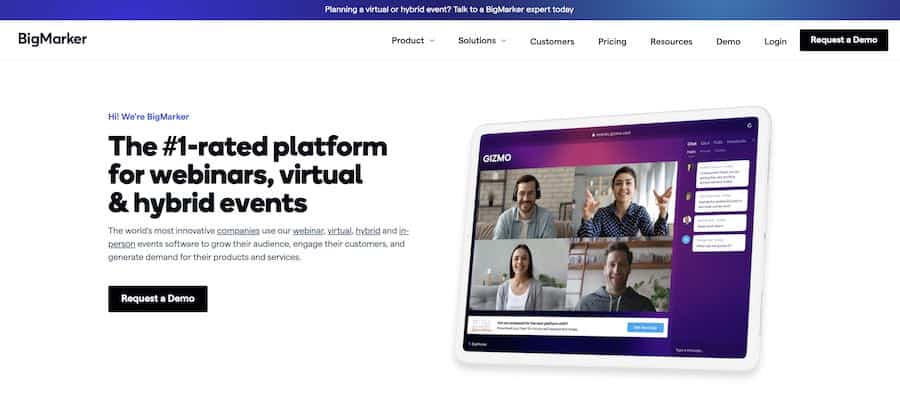
BigMarker is the #1 video platform for webinars, summits, and virtual conferences.
Their live streaming capabilities are where they excel. You can engage up to 10,000 people at once and create an interactive experience with features like polls, handouts, and live Q and As.
There are also no limits on the number of presenters in the webinar – literally, anyone can hop in and join the discussion on screen.
You’re provided with a suite of marketing tools to host these live events, including custom email invites, registration landing pages, and helpful reminders.
With their automated webinars, you can integrate BigMarker with your CRM software to qualify prospects and generate, nurture, and convert your leads.
Here are some ways you can drive sales with BigMarker:
- Create automated webinars to fill your top-of-funnel leads.
- Capture your prospects’ data with embedded forms, surveys, and polls.
- Move prospects down the sales funnel by booking meetings based on their data and lead status.
With BigMarker, you also get extensive third-party integrations with apps like MailChimp, Calendly, Marketo, and more.
Integrations with payment providers like Stripe make it easy for you to manage transactions.
Since it’s a browser-based platform, you don’t need to download or install anything to get into a webinar.
On top of that, it’s compatible with PCs, laptops, tablets, and mobile devices.
Another area they excel in is their white-label offerings. You can build custom video experiences and embed them on your website without coding.
These landing pages, webinars, and emails are all live on your domain so that you own the customer experience.
Key Features:
- Offers unique live streaming features like one-click meetings, Q&A sessions, chats, polls, handouts, etc.
- It has extensive native integrations with apps like Salesforce, Hubspot, Zapier, etc.
- It provides a 7-day free trial period.
- HD video and screen sharing.
- You can stream multiple feeds to Facebook & YouTube Live.
- Build custom live video experiences for online events.
- Offers white-labeled seminar rooms and landing pages.
- It provides over 15 different landing page types.
- Deals in 135+ currencies.
- It comes with industry-standard SSL and HTTPS encryption for data protection.
Pricing Plans:
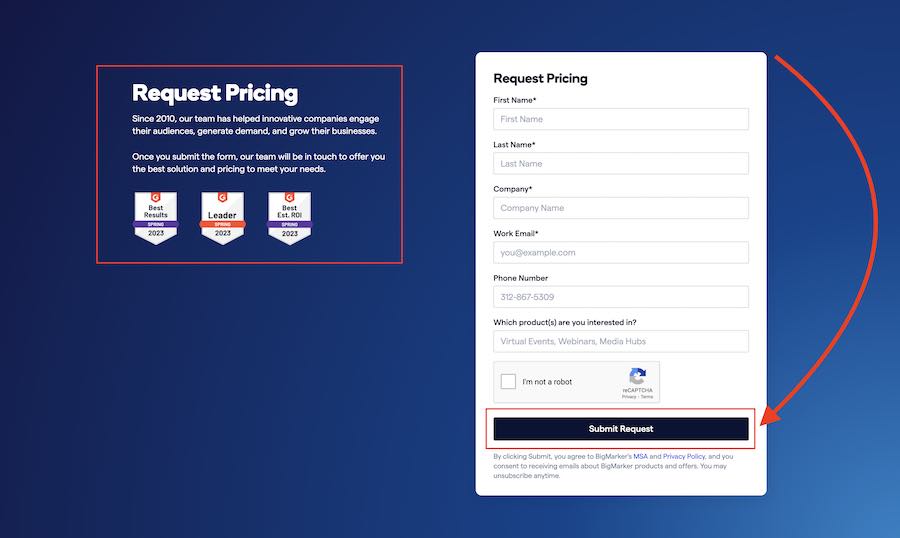
BigMarker offers custom plans to its users. To get a plan, you’ll need to contact BigMarker to decide what custom plan works best for your business’s needs.
Any plan you decide to create includes in-depth analytical tools, pop-up offers, email templates, contact & list management, embeddable webinars, custom URLs, and more.
Suppose you’re looking for a webinar tool to run live events, workshops, town halls, and keynote presentations.
In that case, BigMarker is an excellent choice because of its interactive video features and seamless performance.
Get started with a free 7-day trial of BigMarker.
15. GetResponse.
Best for Easy Email Marketing Integrations ($49/month).
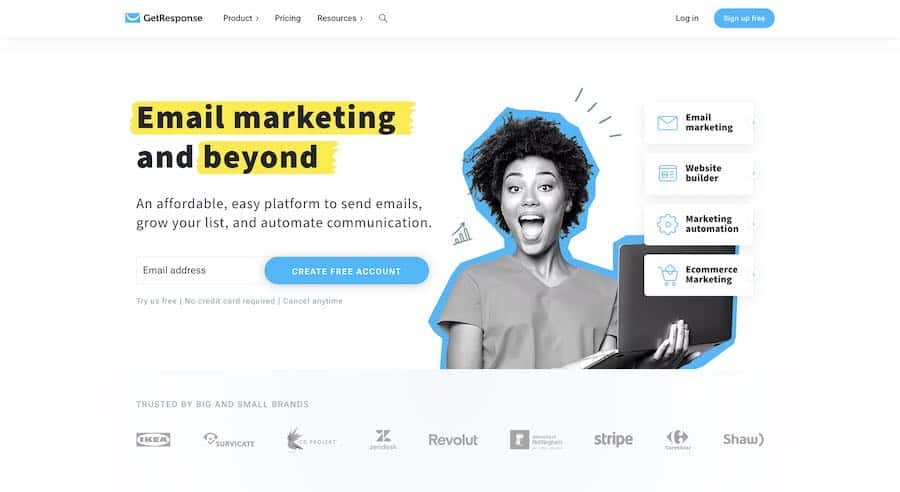
GetResponse is primarily an email marketing platform that offers a wide array of marketing solutions, including a complete webinar marketing solution.
It allows you to set up your webinar within three minutes, sometimes even less.
Other marketing tools include autoresponders, automated email marketing, Landing pages, list segmentation, and more.
KEY FEATURES:
- It allows you to customize your webinar URL.
- Pre-existing webinar invitations and reminder templates with pre-filled webinar details.
- One-click webinar recording.
- Text chat feature to drive engagement.
- One-click sharing options.
- It allows you to set up autoresponders.
- Tracks conversion stats and provides detailed audience statistics.
PRICING PACKAGES:
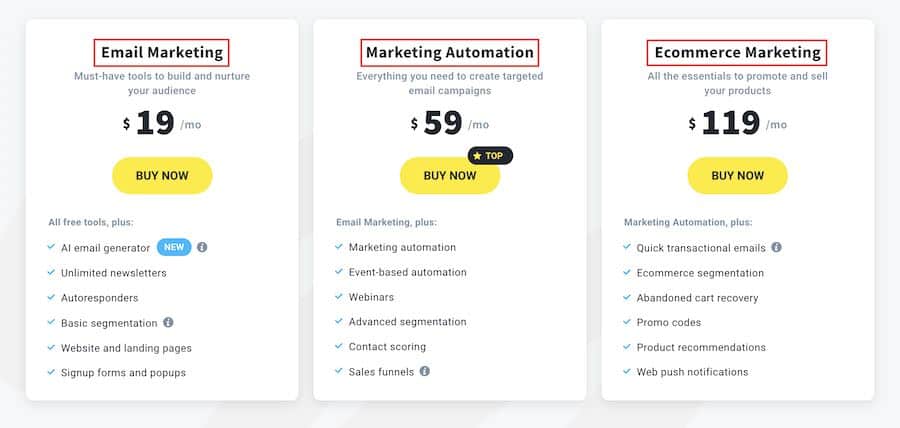
GetResponse has a free 30-day trial and the Email Marketing plan that doesn’t include webinar features.
Their Marketing Automation plan is the first one that provides webinar solutions and starts at $59 per month for up to 100 attendees.
The Ecommerce Marketing plan is $119 per month for up to 300 people.
However, it also includes email campaign consulting and a dedicated account manager.
CONS:
- The free trial provides space for up to 1,000 contacts only.
- Customer support doesn’t include phone support.
- The pricing structure is somewhat complicated. The prices increase exponentially along with your list size.
16. Riverside.
Best for hosting webinars that are simultaneously streamed on multiple channels.
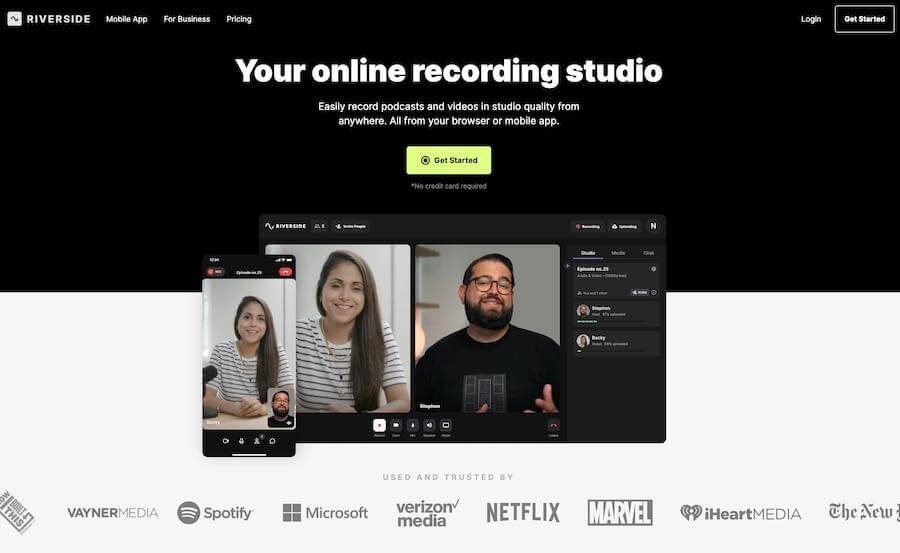
Riverside is an excellent software for larger businesses that want to host webinars.
It offers many features, such as recording webinars with clear uncompressed audio recorded locally at 48kHz WAV.
With their Magic Editor, you may edit your material and streamline it into well-structured webinars.
Riverside’s editor puts all recordings together locally but simultaneously separates the audio and video channels so you can access them independently when editing.
Invite your visitors to record any event, anytime and anywhere. It’s simple to start recording in a few seconds, making it straightforward software to use in different scenarios.
With transcriptions available for your webinars, you’ll be able to follow along as needed.
This way, your audience will feel like they’re receiving a complete experience.
You can also use this feature to quickly find a specific moment in the recording without scrolling through minutes or hours of video.
Simultaneously stream your interview on Facebook, Twitch, Youtube, LinkedIn, and other channels when you want to share it with others.
You’ll be able to ask for feedback from your guests on these various channels as you’re live, which means you can get an insight into what they’re thinking regarding your webinar discussion.
With the ability to have up to eight guests on your webinar, your audience will receive a more personal and interactive experience each time they hop on.
Features:
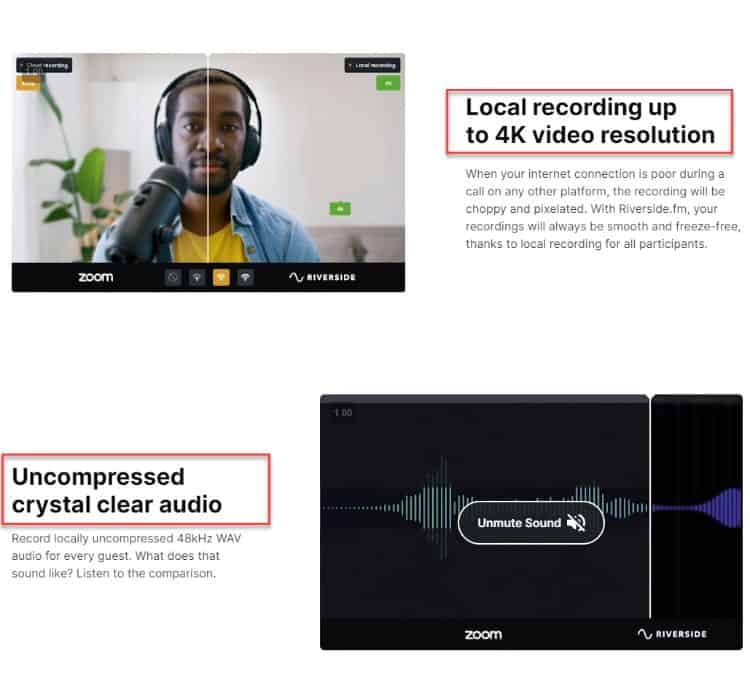
- Guests can easily confirm their participation in your webinar by opening a link in their iOS App or Chrome web browser.
- Share the live recording with others during or after the webinar, which means your guests can watch it later if they can’t make it live on time.
- To assist you, additional tools such as the “Podcast Name Generator” and “YouTube Name Maker” are included with Riverside, making it easier to expand your business.
- TED, Pacific Content Records, and Freakonomics are just a few of the organizations that have worked with Riverside, so you’ll be in good company and can expect quality service.
User Experience:

Riverside provides a great user experience for getting people to attend your webinar.
With the ability to copy the webinar link and immediately set the permission for those that join using the link, Riverside makes it easy for you to get people to your webinar and keep track of who is attending.
Riverside’s user interface is also very well designed, making it easy to find what you need and get started with your webinar.
You can share your screen, choose your microphone and even start recording at the press of a button.
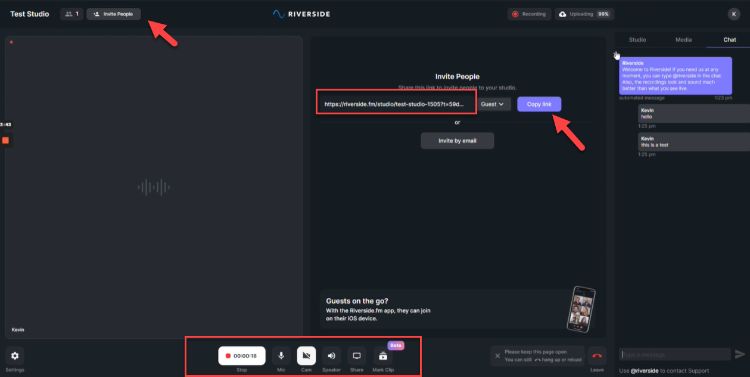
With a well-sized camera preview, you’ll be able to see how you look to those that are attending your webinar.
Pricing:
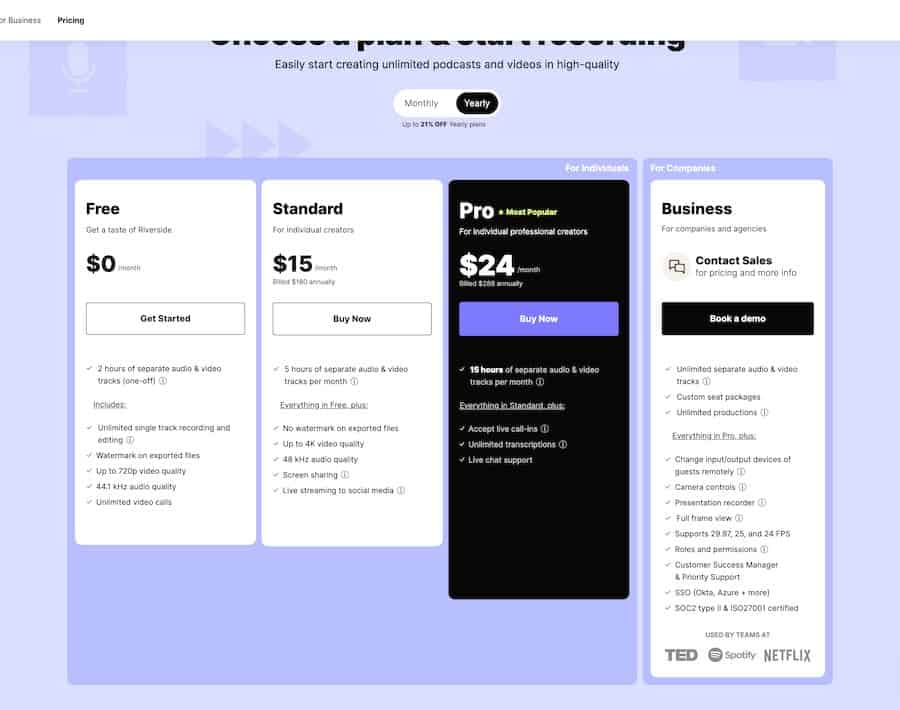
As a new user, you can get a free trial to experience all of the features for up to one hour, without needing to enter any credit card details.
After that, the annual pricing plans are as follows:
- Free: Up to 2 hours of recording monthly
- Standard: Up to 5 hours of recording monthly: $180
- Pro: Up to 15 hours of recording monthly: $288
- Business: Get in touch with their sales team for a custom quote.
With the annual prices mentioned above, you’ll save up to 21% compared to paying monthly.
What I Like / Dislike About Riverside:
Like:
- One can use a lot of helpful documentation to get started with Riverside. With information about their iOS app, troubleshooting issues, questions about how to manage your podcasts, prepare your green room, and more, you’ll never be left alone.
- There’s also a live chat feature on their website, with the promise of getting an answer to your queries within a few hours.
Dislike:
- Some report issues with guest URLs when setting up their webinars, but that seems to be the biggest recurring complaint.
- Others say the price is on the higher side, but with the features you get, that is to be expected.
Product Updates:
- Multi-layout clips allow you to create clips for Tiktok so that your content can be reused on multiple platforms.
- Riverside also introduced its iOS apps, which means you can now create and edit content on the go!
17. Adobe Connect.
Best for Large Marketing Organizations and Agencies.
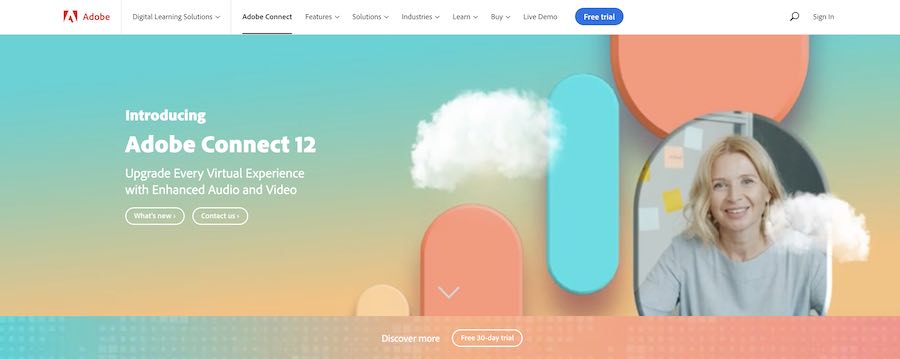
A frontrunner in innovation and technology, Adobe has forayed into webinar platforms with Adobe Connect Webinars.
Besides creating webinars, it allows you to host videos, share documents, and host meetings for increased customer interaction.
Moreover, it will enable you to customize your hosting room and optimize it per your requirement.
Adobe Connect helps marketing companies and firms showcase their products and services in an impactful way to their target audience.
KEY FEATURES:
- It provides a variety of templates to customize your virtual environments.
- It helps you create unique registration pages.
- Ability to influence and reach out to target audiences with videos, blogs, surveys, and polls.
- It offers robust analytics for better insights.
- Integrates easily with CRM software like Eloqua and Salesforce.
PRICING PACKAGES:
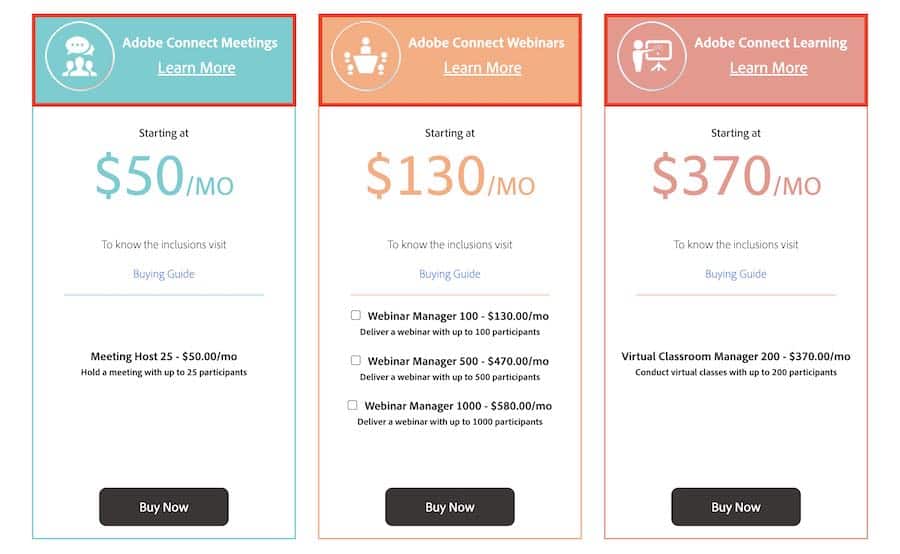
Adobe Connect comes with a moderate price tag.
For 25 seats, it is $50 per month, $130 per month for 100 seats, $470 for 500 seats, $580 for 1,000 seats, and for schools there’s the Adobe Connect Learning plan $370 per month for 200 seats.
Each plan allows you to host unlimited events. Moreover, you get a 30-day free trial to test out the product.
CONS:
- Mobile devices have had some rare display video and audio compatibility issues.
- One of the highest prices for webinar software.
18. WebinarsOnAir.
An Affordable Option for Mid-Tier Webinars.
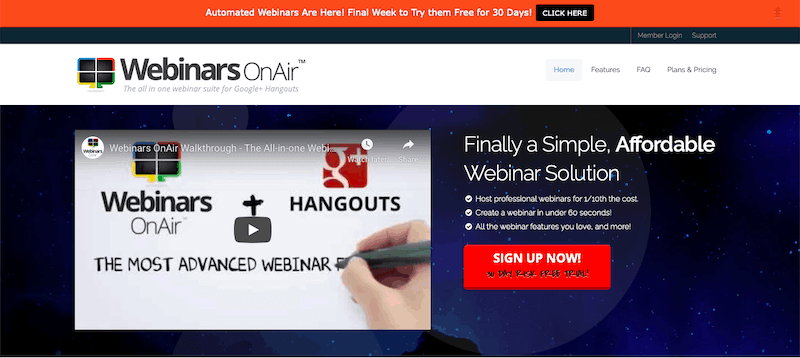
If affordability is your main concern, then WebinarsOnAir is the perfect platform.
On top of that, it comes with all the fantastic features required to host an excellent webinar.
It’s also exceedingly user-friendly for the host and the viewers. Offered by G Suite, it allows you to set up your room.
Moreover, it exposes you to various exciting features, including recurring webinar options, polls, surveys built into the webinar, Q and A, and so forth.
It is entirely hosted in the cloud, thus offering extensive scalability power.
With WebinarsOnAir, you can also keep track of your audience count, conversion rate, and other vital metrics.
KEY FEATURES:
- You can schedule a webinar for up to 50,000 attendees in less than a minute.
- Offers “Tracking Pixels,” which allows you to create “laser-targeted audiences for retargeting purposes.”
- Live Q&A sessions along with live chats.
- Allows ten moderators/speakers at once.
- One-click webinar registration.
- Offers in-built opt-in forms.
- Cloud-based hosting.
PRICING PACKAGES:
There is a 30-day free trial.
Then, the plan for 25 viewers costs $19.97 per month.
For unlimited participants, the plan costs $99 per month.
19. Google Hangouts.
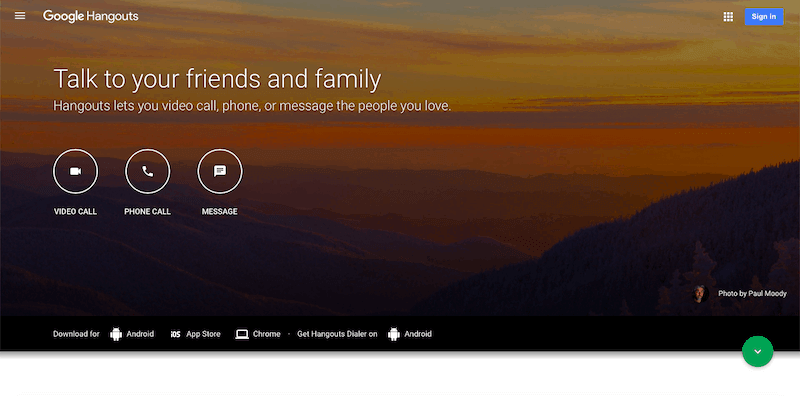
One of the most famous names on this list, Google Hangouts, is an entirely free solution that easily integrates with the Chrome Browser and Gmail.
You can either host a webinar for up to 30 prospects or stream it on YouTube to invite a more extensive audience base.
Google Hangouts is one of the best free software choices because it caters to every business size, whether a small or medium-sized business or a large corporation.
It also allows several people to speak and share their screens during the webinar and record the meetings.
Since it’s free, there are some main downsides compared to other tools on this list.
For example, while it’s suitable for quick 1:1 meetings, you don’t get any automation or marketing features.
KEY FEATURES:
- Allows up to 30 people in the chat.
- Several speakers can speak during the webinar.
- Completely free of cost.
- The recording is done automatically and uploaded on your YouTube channel right away.
- It can create a webinar in 10 seconds.
- Integrates with YouTube and Chrome.
- No additional software download is needed.
- Easy screen share features.
PRICING PACKAGES:
Free, but limited for those looking to optimize their sales funnel.
CONS:
- A Google account is a necessary prerequisite.
- Unlike other tools on this list, Google Hangouts does not offer additional marketing features, such as analytics, paid events, email marketing, etc.
20. Livestream.
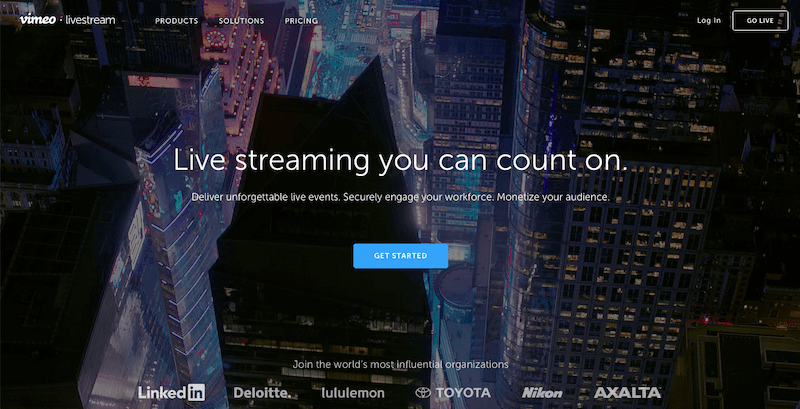
Livestream is an excellent webinar tool catering to big businesses and educational institutions.
It’s best suited for organizations that have already engaged and built a relationship with their target audience.
There’s no maximum limit to the number of attendees; an unlimited number of participants can view your webinar.
One of the best parts about Livestream is that it offers unlimited storage and automatically records and stores all your webinar events in the cloud.
Other prominent features include limitless streaming analytics, the ability to stream to Facebook Live or YouTube, live Q&A and polls, audience chat, lead generation tools, and so forth.
You also get dedicated phone support for your webinar events and can even privatize your event’s access.
KEY FEATURES:
- Unlimited storage and unlimited viewers.
- Outstanding customer support.
- It allows you to privatize your events.
- Private link sharing.
- Extensive in-built analytics.
- Stream to Facebook Live or YouTube.
- You can embed the webinar into your website.
PRICING PACKAGES:
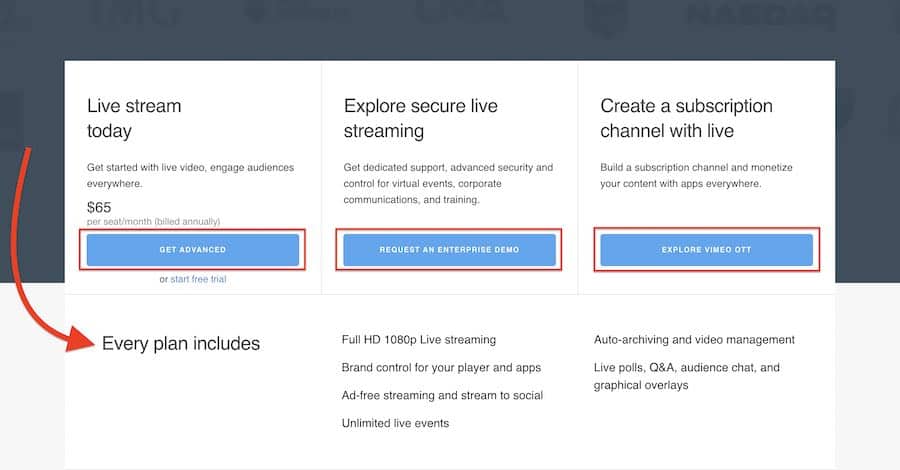
It costs $65 per month if billed annually with the Advanced plan. Livestream offers a quote-based Enterprise package with additional features such as a dedicated account manager, auto-archiving, pay-per-view option, and more.
CONS:
- Some reviews suggest that there are some rare occurrences of connectivity lags.
- They don’t offer a free trial.
21. Zoom.
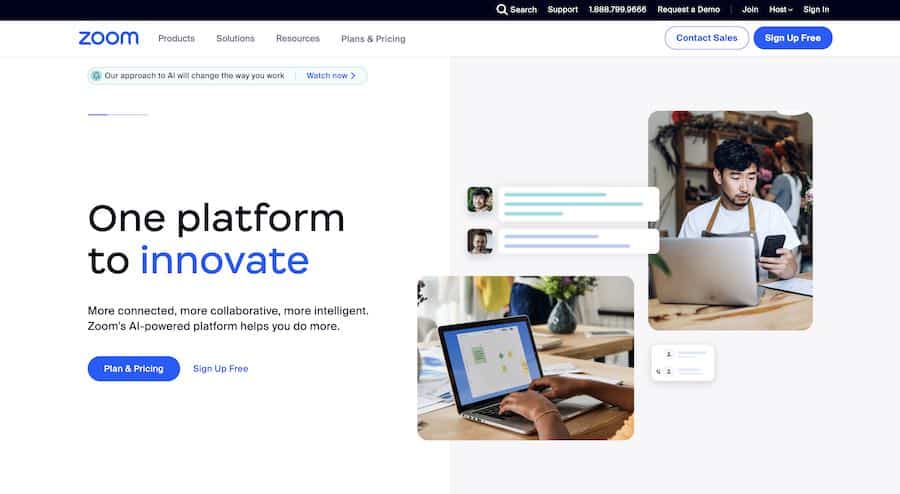
Zoom is today’s most popular webinar software, connecting friends and colleagues worldwide across different time zones.
Some reasons to use Zoom are that it’s intuitive, entirely cloud-based, and has a user-friendly interface that makes things easy for its users.
It performs many activities that make it an asset to any company. Zoom offers HD video and audio, screen sharing, desktop, and app sharing options.
Moreover, it allows you to host scheduled and unscheduled meetings and keeps a backup of every session in the cloud for ready and instant access later.
Their web conferencing software also allows private and public chats so that the audience does not necessarily have to interrupt the speaker while he or she is making a point.
It also integrates with Google Calendar and Microsoft Outlook, allowing users to schedule meetings and send emails seamlessly. Zoom is a one-stop shop for everything when it comes to hosting a webinar event.
KEY FEATURES:
- HD video and audio, along with screens sharing facility.
- Desktop and app sharing options.
- Backup of every meeting in the cloud.
- It allows private and public chats, letting your viewers communicate during the event without interruption.
- Provides free access to up to 100 participants and 40 mins limit on group meetings.
- Efficient host controls and virtual whiteboards.
- User-friendly and easily navigable dashboard.
- There are no one-time fees, and it’s free to sign up.
PRICING PACKAGES:

It is one of the best webinar platforms that provide a freemium package. The Basic plan offers 40 minutes on the webinar and allows up to 100 participants. The Pro paid plan offers every feature and 1 GB of cloud recording, costing $149.90 per year.
The Business package, ideal for small and medium-sized businesses, is $199.90 per year. The Business works as well, costing $250 per year. The Enterprise plan is for larger scale businesses, contact sales for more info.
CONS:
- Some reviews suggest that the audio quality should be improved.
- Some users have complained that the calls get automatically disconnected sometimes.
- Zoom isn’t higher on this list because while it’s great for quick meetings, it doesn’t have the deep marketing and automation features that others tools on this list have.
22. AnyMeeting.
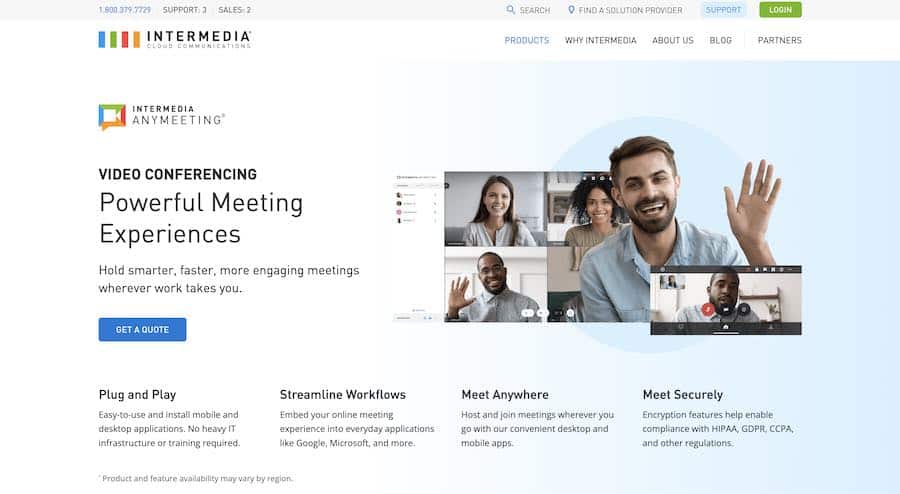
Perfect for small organizations, startups, and educational institutes, AnyMeeting offers essential tools to host your webinar and a user-friendly and intuitive interface.
Solid features include HD video broadcasting, screen sharing, MP4 sharing, in-built surveys, automatic webinar recording, and more.
AnyMeeting offers varied pricing packages that allow you to host up to 1,000 attendees.
You also get a 30-day free trial to test the webinar platform and check whether it aligns with your preference.
Along with the Webinar hosting options, AnyMeeting also provides web conferencing tools that allow you to conduct collaborative sessions with your fellow team members, prospects, to clients.
KEY FEATURES:
- Up to 6 live speakers and up to 1,000 participants.
- Provide options for real-time audience chat.
- Offers in-built Q&A sessions, live chat, polls, and surveys to engage your audience.
- Follows-up with your attendees via emails.
- Intuitive and user-friendly interface.
- A free 30-day trial at the start so that you make sure that the environment suits you.
- It offers robust analytics and built-in reporting.
PRICING PACKAGES:
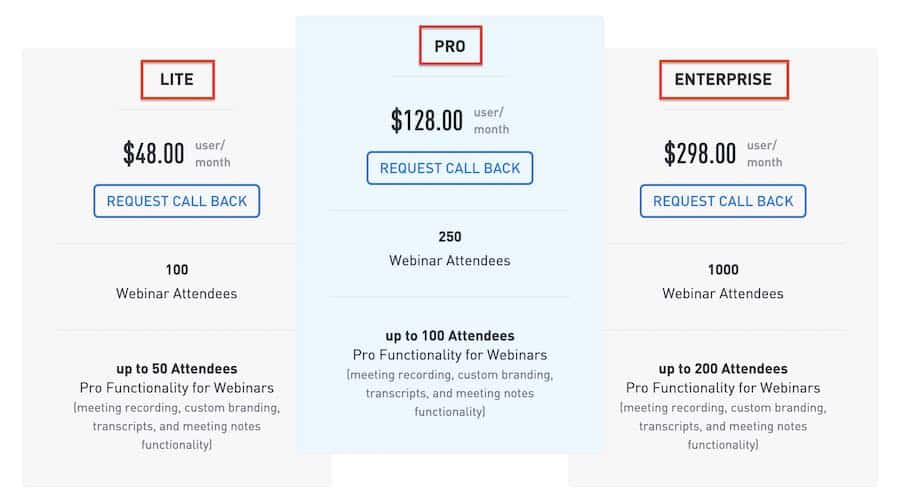
The basic plan called Webinar Lite is $48 per month for 100 viewers; Webinar Pro, which allows up to 250 viewers, is $128 per month, and $298 per month for the Webinar Enterprise plan, which allows up to 1,000 people.
CONS:
- Some would say it is a little overpriced, but the value it brings to the table makes it worthwhile.
- It does not allow broadcasting from mobile devices.
23. Webex.
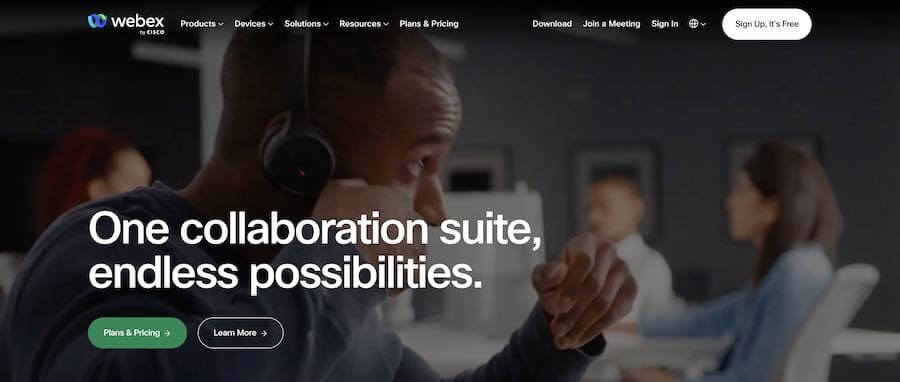
A Cisco product, Webex lives up to the expectations of having such an acclaimed parent company.
It provides some impressive features, such as a host room and HD video and audio services that can be accessed on multiple devices.
It allows its users a high degree of customization so that the host environment can be tailor-made to suit business requirements.
Through Webex webinars, you can hold meetings throughout your organization, offer online and offline training sessions, and provide remote support.
The key USPs of Webex include mobility, user-friendliness, and compatibility with all devices and browsers.
It is a cloud-based platform, so along with superior speed, there is a guarantee of data security.
KEY FEATURES:
- Cloud-based platform.
- It allows you to host up to 40,000 attendees.
- Built-in Q&A sessions, polls, and surveys to facilitate audience engagement.
- It provides a mobile app.
- Strong customer service.
- The excellent HD video and audio quality.
- Integrates with popular marketing tools like Salesforce.
PRICING PACKAGES:
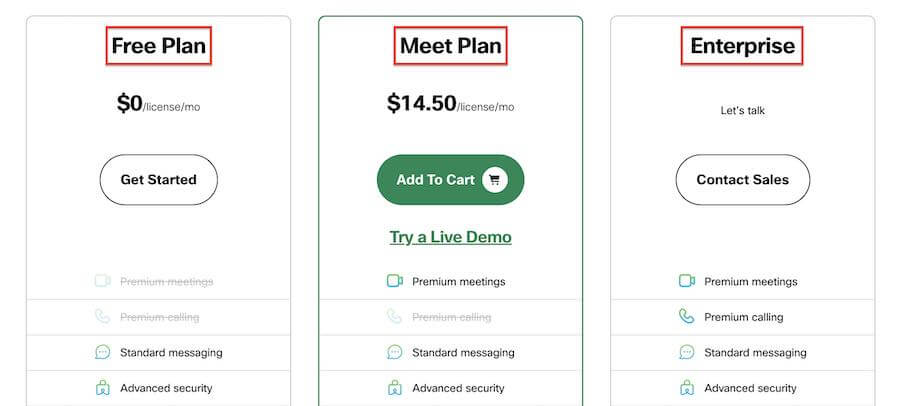
The Meet plan costs $14.50 per month for up to 50 participants if billed annually. Contact sales for more information on the Enterprise plan.
CONS:
- More suited for in-house team collaboration than webinars.
24. DaCast.
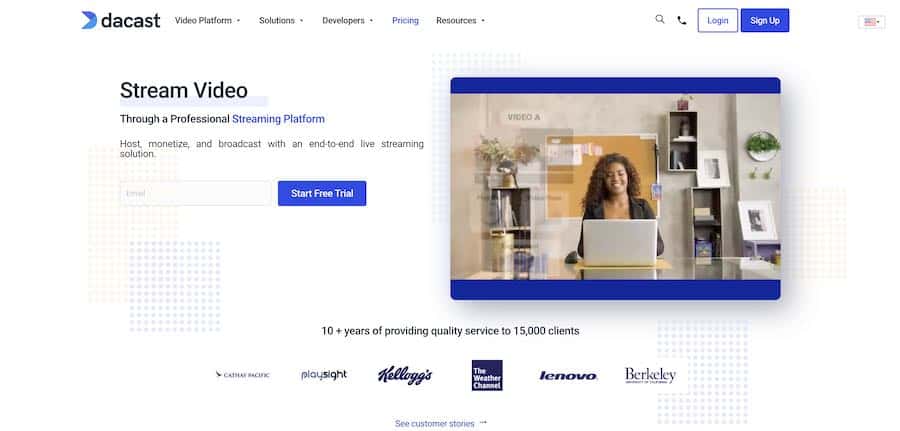
DaCast is another great webinar software platform that helps you set up your online video conferencing environment within minutes.
It offers impressive broadcasting features to help you manage, monetize, and analyze your online video.
Along with secure video hosting, you get 24/7 customer support that is handy if you get stuck in the process.
Popular features include integrating live video with APIs and streaming over social media platforms like Facebook.
With these features, you can shoot live webinars and then offer your on-demand webinars later.
Simply put, it is a quick and easy-to-use platform that can be used even by novice marketers.
KEY FEATURES:
- No viewer limits.
- Allows FTP access.
- Real-time analytics.
- An interactive video-on-demand (VOD) solution.
- Live streaming on social media platforms.
- User-friendly web conferencing interface.
- Easy to set up.
- Strong customer service.
PRICING PACKAGES:

The paid plans start at $39 per month (billed annually) for up to 300 viewers per hour and range up to $165 per month (billed annually) for up to 15,000 viewers per hour. There is one quote-based custom plan as well that allows you to cherry-pick the features you require.
CONS:
- Their webinar services are based on how much data you consume. You will be charged extra if you go over the data bandwidth limit.
Reviews of Zoho Meetings, Airmeet, and LogMeIn are coming soon.
25. Communique.
Best for Enterprise Level Features.
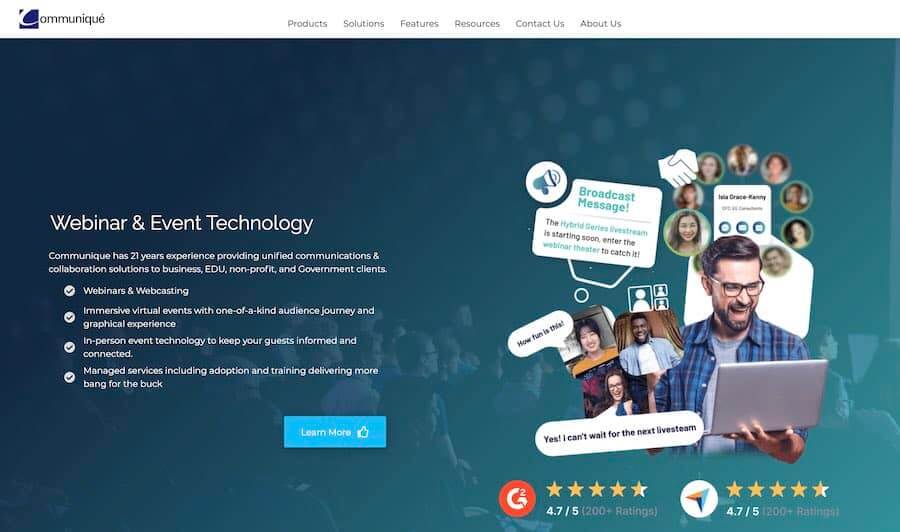
Communique provides features typically found in enterprise-level webinar platforms but without the enterprise-level price tag.
Users can customize their webinars with a flexible user interface to match their brand.
Users can also brand their webinars with their company logo, colors, and fonts, so participants always know whose webinar they’re attending.
Additionally, you can scale to any audience size so the platform can grow with you as your needs change.
KEY FEATURES:
- Audience engagement ensures that everyone who attends your webinar is fully engaged.
- The real-time data & analytics let you see how well your webinar is doing in real-time so you can make adjustments on the fly if needed.
- Registration pages & e-mails make it easy for participants to sign up and receive reminders about your upcoming webinar.
- Recording & editing let you go back and review your webinar later or create an edited version to share with those who couldn’t attend.
- 3rd Party integrations allow you to connect Communique with the tools you already use, such as your CRM or marketing automation platform.
- HD adaptive bitrate video ensures that everyone who joins your webinar has a high-quality experience, no matter their internet connection.
PRICING PACKAGES:
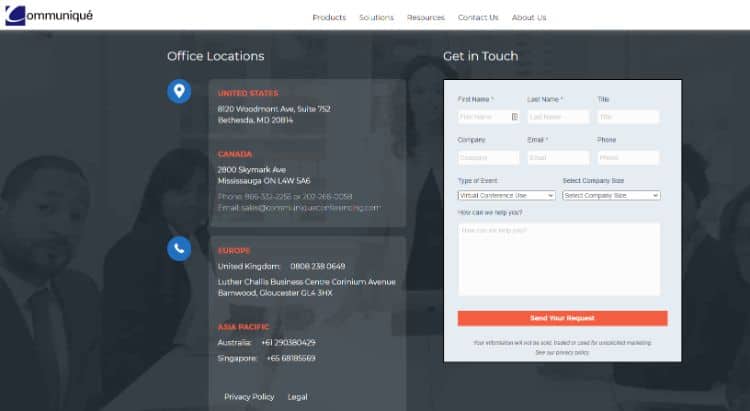
You’ll have to contact the sales team to get pricing information.
CONS:
Some more user-friendliness can be incorporated in various areas to ensure that everyone can immediately understand the user interface and controls.
Our Top Picks.
That concludes our list of the best webinar software to use this year.
Here’s a quick summary of our top picks:
- Livestorm is the best webinar software overall.
- Demio is the best webinar software for marketing teams.
- Zoho Meeting is the best webinar and conferencing platform.
- WebinarJam is one of the best webinar platforms for sales funnels.
- WebinarNinja is the best webinar software for online coaches.
- BlueJeans is one of the best webinar software platforms for large events.
What is Webinar Software?
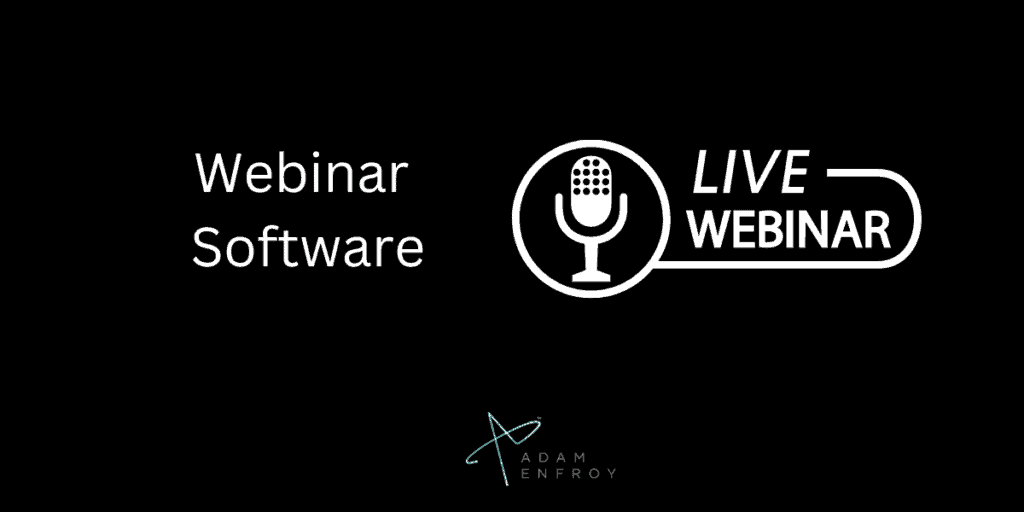
A webinar is a form of web conferencing that is essentially a blend of the words web and seminar.
Webinar software runs this online video conference meeting.
It’s better defined as a lecture, live presentation, meeting, or event conducted online and attended by an entire audience.
The software that is used to run and conduct a webinar is webinar software. These webinar tools help make your webinars more interactive, engaging, and flexible.
There are multiple options on the market, including Livestorm, Demio, and Zoho Meeting.
The best webinar software makes it easy to record, share, and follow up with your prospects without difficulties or downtime.
The best webinar software tools are Livestorm, Demio, WebinarJam, Webinarninja, and GoToWebinar.
Overall, a webinar tool for small businesses should help you deliver live high-quality video and sync with your email lists.
It should also help you automate your sales process and engage with your MQLs with live training and product demos.
Plus, most video conferencing tools include built-in surveys, polls, email marketing software, live-chat features, automated webinar sequences, streaming capabilities, and more.
These automated webinar sequences are excellent for hosting evergreen content like online courses, podcast interviews, or employee onboarding videos.
What Are the Benefits of Webinar Software?
Using webinar tools to host your event or presentation has many benefits.
Here are some of the top benefits:
1. Webinar Software is Cost-Effective.
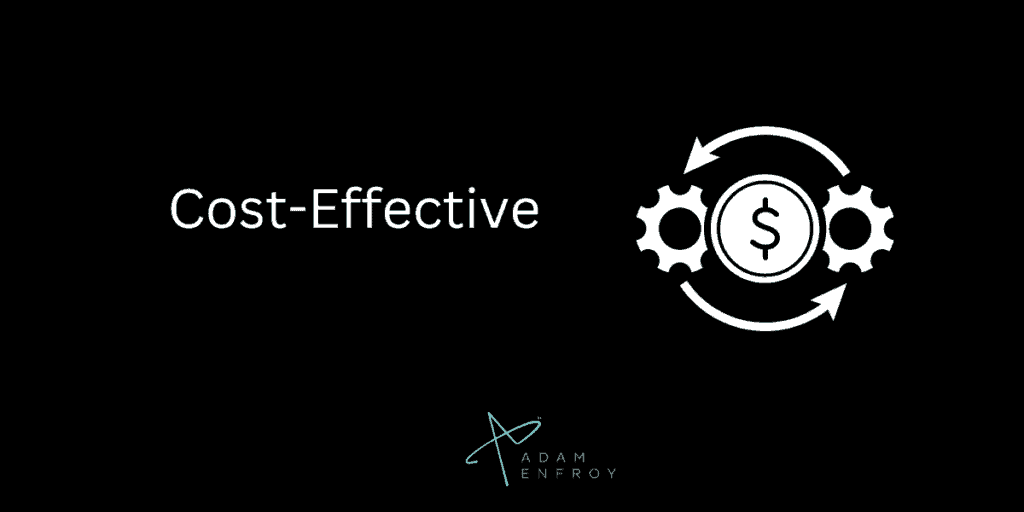
Webinars cater specifically to an online audience of people who are already interested in what you’re selling.
And unlike webcasts, there’s no physical location necessary for everyone to join.
Thus, you don’t need to pay for many things a physical seminar would entail, like renting a room and paying for space.
The attendees don’t have to pay much (if anything) to attend these online meetings, and they make excellent business sense for them, too.
The only things you need for a live webinar are the following:
- A webcam.
- A script with engaging content.
- A good internet connection.
- A set of interested people.
- Good webinar software to host and record your webinar.
- Either an excellent microphone or just an internal computer microphone.
- Guest speakers and assistants with expertise.
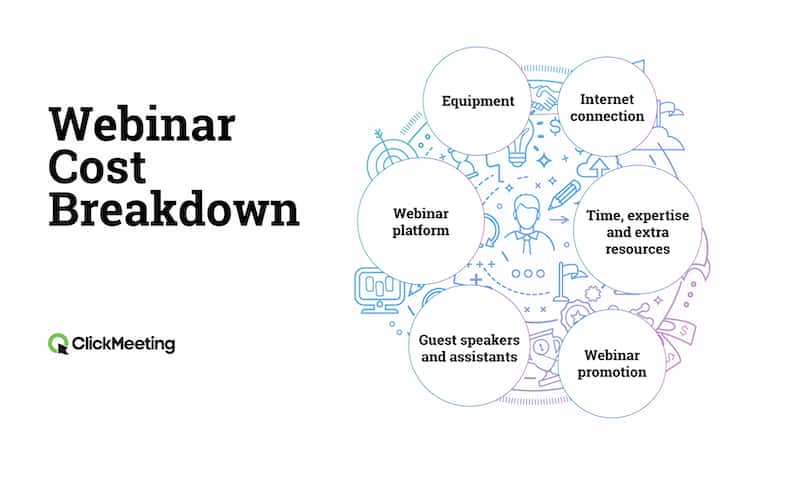
The cost of arranging a webinar is usually between $100 to $3,000, which is a fraction of the cost of organizing a live, physical conference.
However, using a webinar tool like WebinarJam can save a lot of money as it only costs $1 for a 14-day trial.
Thus, it’s a very cost-effective medium for engaging your prospective leads.
2. Webinar Platforms Expand Your Audience.

Using software to create your webinars can help you do away with the problems of social media integrations and setting up billing.
All these platforms allow you to reach a broad audience worldwide, no matter where you are.
The logistical cost of attracting people from all over the world for an in-person conference isn’t possible in most cases unless a 6, 7, or 8-figure deal is agreed upon.
That’s beyond the reach of most small and medium-sized businesses.
On the other hand, webinars allow you to target prospective leads all across the globe at virtually no logistical cost or support involved, no matter the size of your business.
3. Webinar Software Improves Lead Generation.

According to statistics, 73% of B2B marketers and sales leaders suggest that webinars are the best way to generate high-quality leads.
With the right strategy in place, you can turn your webinar into a well-oiled and automated machine, churning out leads over time.
The webinar participants usually attend it due to their professional or personal interests.
While not everyone is a potential customer, it’s vital to recognize who they are and target them via email based on their interests and actions.
Most webinar software offers lead generation and marketing tools that help you soft-sell your products, focus on the value they create, and steer your users down the sales funnel.
Take EverWebinar, for instance:
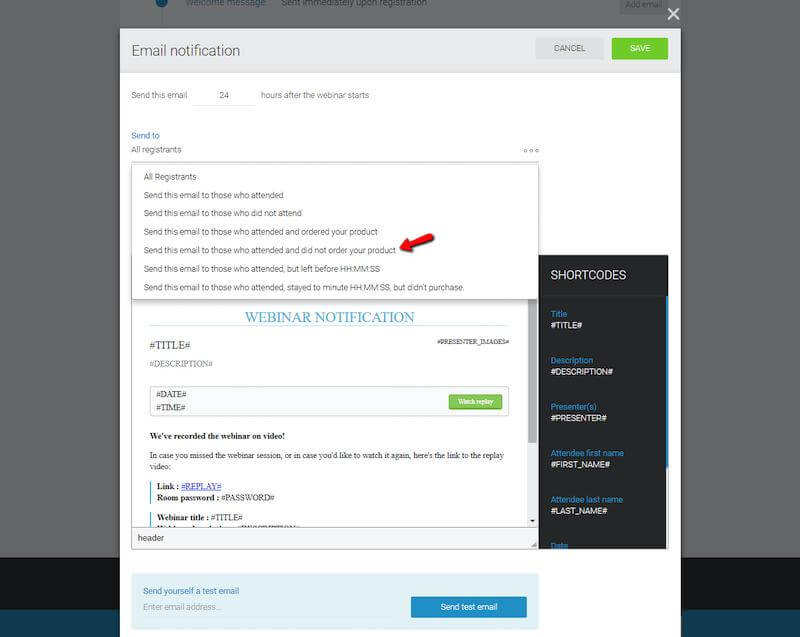
They help you send automated follow-up emails, communicate with your subscribers before and after the webinar, and allow you to customize your messaging.
All these fantastic features help you generate more leads than you could ever do if you host a regular webinar.
4. Webinar Platforms Allow Guest Presenters.

Webinars offer plenty of ways to create engaging and enriching presentations for your potential customers.
One way to generate interest is by inviting guest speakers to your webinars.
Getting a guest speaker on board is an excellent way to boost your credibility. Naturally, industry experts endorsing a webinar usually build trust with your audience.
Moreover, an industry leader will likely have a lot of peer interaction and a large professional following.
By getting an influential member of the industry to speak on your behalf, you stand a great chance of tapping into their entire contact list.
Most webinar platforms give you the option of hosting webinars with multiple presenters, which allows you to invite some influential guests to engage a wider audience.
One example is WebinarJam.
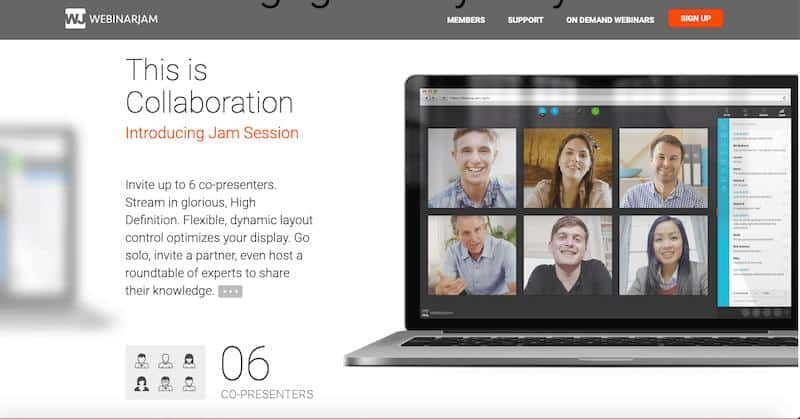
They allow you to invite up to six co-presenters and even host a roundtable of experts to share their knowledge.
5. Webinar Software Helps Build Domain Expertise.
Webinars are personal interactions and can increase your domain expertise while connecting you with a new following.
As you continue creating webinars, more and more people attend, you scale up your brand recognition, and you pick up a lot of domain knowledge – plus soft skills in presenting and webinar management.
Recognizing as a thought leader and industry stalwart can improve customer retention and customer lifetime value for your business, which can help you boost sales in the long term.
Webinar Platforms – Summary.
Owing to their impressive and user-friendly features, these are some of the best webinar tools available today.
But the question is which webinar software platform is best for your business. To identify this, you need to take several things into account. For starters, see your budget and then compare the features accordingly.
Then you need to identify what size your audience is and what features you might require to engage them.
The best part is that most of these tools come with a free trial or money-back guarantee, allowing you to test the product before upgrading to a paid plan. You can make the final purchase when you find what you want.
Which webinar software do you plan to use?
Further reading on AdamEnfroy.com: Combining membership sites and webinar software can be a powerful way to create an effective business model. By combining the two, you can offer a complete package of products and services that will keep users engaged and coming back for more.
Last Updated on September 29, 2025 by Adam Enfroy
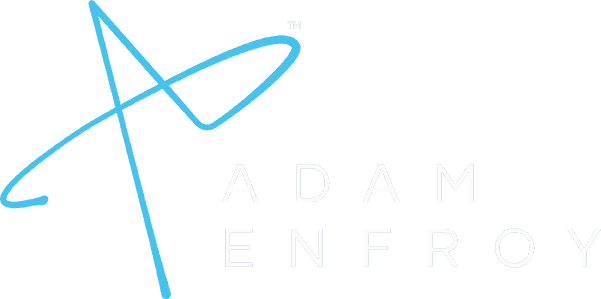




Hey Adam, what a great depth article about webinars, webinar software and all that is relevant. I will use some of these tips for my work in The Netherlands, thnx!!
Hello Adam,
I have found your site from Google while searching for this kind of software to improve my knowledge and doing some research on my existing projects.
Few blogs from your website like- Webinar jam review help me a lot. Thanks for sharing this valuable and in-depth information.
Regards
Dipanjan
Glad you found it helpful.
I was confused about webinar software. Your post has helped me a lot to find good software. Webinarjam is quite cool.
Glad it was helpful – thanks.
One of the best summaries of webminar tools on the internet. Thanks!
Thanks Andrew
Hi Adam, this is great.
I am looking for a software where I can run few webinars simultaneously. Zzoom doesnt allow that with one account. I have to open few account and manage from there and that’s very very difficult and confusing.
Super article, helps clear the jungle
Hi Adam!
This is a great article about best webinar service providers. It’s very cohérent and smooth to read and understand. Honestly, it’s a well done job. Keep it up. I’m learning a lot from you. Best wishes